














Headmaster Andrew Baker
Deputy Head: Teaching & Learning Mandy Gruzd
Director of Foundation & Administration Danie Botes
Director of Operations & Student Affairs Andrew Murewa
Director of Leadership Siobhan Glanvill-Miller
Campus Rabbi Rabbi Rabinowitz
Head of Hebrew & Chagim Hanna Ben-Moshe
Head of Arts & Culture Renos Spanoudes
Head of Sport Thulani Ndlovu
Grade 8 Danie Botes
Grade 9 Ntombi Mota
Grade 10 George Morfis
Grade 11 Siobhan Glanvill-Miller
Grade 12 Andrew Murewa
COUNSELLING & EDUCATIONAL SUPPORT
Social Worker Gita Lipschitz
Educational Support Jolene Macintosh
Language Specialist Elise Levin
Occupational Therapist Carla MacDonald
DEPARTMENTAL STAFF
English Heidi Seligman (HOD)
Gila Katz
Ronel Klatzin
Simone Krawitz
Elizabeth Leaver


Afrikaans
isiZulu
Hebrew
Nadia Steenekamp (HOD)
Henning Blignaut
Magda-Lize Rohde
Ntombi Mota (HOD)
Hanna Ben-Moshe (HOD & Chagim)
Keren Barashi
Lior Fradkin
French Laurence Hodes (Part Time)
Ronel Klatzkin
Mathematics
Mathematical Literacy
History
Geography
Life Sciences
Physical Sciences
Accounting
Liesel le Roux (HOD)
Ari Levin
Lauren Myers
Caitlin Shippey
Hayley Kobrin
Mandy Gruzd (HOD)
Siobhan Glanvill-Miller
Mairi Nel
Mairi Nel (HOD)
George Morfis
Danie Botes (HOD)
Henning Blignaut
Ishara Govender
Shandhinee Nargaroo
Ishara Govender (HOD)
Shandhinee Nargaroo
Daniel Smuts (Locum)


Business Studies
Andrew Murewa (HOD)
Liesel Le Roux
George Morfis
Nikki Richard
Computer Applications Technology
Information Technology
Arts & Culture
Life Orientation
Jewish Studies
Consumer Studies
Tourism
Sport
Denise Vythilingam (HOD)
Yael Gordon
Denise Vythilingam (HOD)
Renos Spanoudes (HOD & Arts and Culture)
Fiona Couldridge (HOD Visual Art)
Nikki Richard (HOD Music)
Sharon Brummer (HOD)
Rabbi Rabinowitz (HOD)
Gila Katz
Keren Munnell
Sherran Borland (HOD)
Sherran Borland (HOD)
Thulani Ndlovu (Head of Sport)


Grade 12 Head: Andrew Murewa
12V Ari Levin
12I
12C
11V
11I
10V
10I
10C
9V
9I
9C
8V
8I
Nadia Steenekamp
Denise Vythilingam
Grade 11 Head: Siobhan Glanvill-Miller
Magda-Lize Rohde
Liesel le Roux
Grade 10 Head: George Morfis
Keren Munnell
Lior Fradkin
Ronel Klatzkin
Grade 9 Head: Ntombi Mota
Caitlin Shippey
Nikki Richard
Heidi Seligman
Grade 8 Head: Danie Botes
Henning Blignaut
Ishara Govender


FRONT OFFICE: (011) 446 7860
FAX: (011) 888 7405
Management
Headmaster
Andrew Baker bakera@sabje.co.za
Deputy Head: Teaching & Learning Mandy Gruzd gruzdm@sabje.co.za
Director: Operations & Student Affairs Andrew Murewa murewaa@sabje.co.za
Director: Foundation & Administration Danie Botes botesd@sabje.co.za
Director: Leadership Siobhan Glanvill-Miller glanvills@sabje co za
Campus Rabbi
Rabbi Rabinowitz rabinowitzm@sabje.co.za
Head of Hebrew & Chagim Hanna Ben-Moshe benmosheh@sabjeco.za
Head of Dramatic Arts & Culture Renos Spanoudes spanoudesr@sabje.co.za
Head of Sport Thulani Ndlovu ndlovut@sabje co za
Grade Heads
Grade 8 Danie Botes botesd@sabje co za
Grade 9 Ntombi Mota motan@sabje.co.za
Grade 10 George Morfis morfisg@sabje.co.za
Grade 11 Siobhan Glanvill-Miller glanvills@sabje co za
Grade 12 Andrew Murewa murewaa@sabje.co.za


Administration & Finance
Head’s P.A. Jackie Conradie conradiej@sabje.co.za
Administrator Andrea Kattan kattana@sabje.co.za
Financial Administrator Lerato Kutoane kutoanel@sabje.co.za
Communication & Design Yael Gordon gordony@sabje.co.za
Marketing Manager Nirvana Rogers rogersn@sabje.co.za
Facilities Manager Fabio Conte contef@sabje.co.za
Security Methusalem Motloadi
Counselling & Learning Support
Social Worker Gita Lipschitz lipschitzgi@sabje.co.za
Educational Support Jolene Macintosh macintoshj@sabje.co.za
Speech & Language Therapist Elise Levin levinel@sabje.co.za
Occupational Therapist Carla MacDonald macdonaldc@sabje.co.za


BARASHI, Mrs Keren barashika@sabje co za
BEN MOSHE, Mrs Hanna benmosheh@sabje.co.za
BLIGNAUT, Mr Henning blignauth@sabje.co.za
BORLAND, Miss Sherran borlands@sabje.co.za
BOTES, Mr Daniel botesd@sabje.co.za
BRUMMER, Mrs Sharon brummers@sabje co za
COULDRIDGE, Ms Fiona couldridgef@sabje co za
FRADKIN ,Mr Lior fradkinl@sabje co za
GLANVILL-MILLER, Mrs Siobhan glanvills@sabje.co.za
GORDON, Ms Yael gordony@sabje co za
GOVENDER, Mrs Ishara govendori@sabje co za
GRUZD, Mrs Mandy gruzdm@sabje.co.za
KRAWITZ, Ms Simone krawitzs@sabje.co.za


KATZ, Mrs Gila jankelowitzg@sabje.co.za
KLATZKIN, Mrs Ronel klatzkinr@sabje.co.za
KOBRIN, Mrs Hayley kobrinha@sabje.co.za
LE ROUX, Mrs Liesel lerouxl@sabje co za
LEAVER, Dr Elizabeth leavere@sabje co za
LEVIN, Mr Ari levinar@sabje.co.za
LEVIN, Mrs Elise levinel@sabje.co.za
LIPSKAR, Rabbi Levi lipskarl@sabje.co.za
LIPSCHITZ, Mrs Gita lipschitzgi@sabje co za
MACDONALD, Mrs Carla macdonaldc@sabje co za
MORFIS, Mr George morfisg@sabje co za
MOTA, Mrs Ntombi motan@sabje co za
MUNNELL, Mrs Keren nochumsohnk@sabje co za
MUREWA Mr Andrew murewaa@sabje co za
MYERS, Mrs Lauren myersl@sabje,co za


NARGAROO, Mrs Shaan nargaroos@sabje.co.za
NEL, Mrs Mairi nelm@sabje.co.za
RABINOWITZ, Rabbi Mendel rabinowitzm@sabje.co.za
RICHARD, Ms Nikki richardn@sabje co za
ROHDE, Mrs Magda-Lize rohdem@sabje co za
SELIGMAN, Mrs Heidi seligmanh@sabje co za
SHIPPEY, Ms Caitlin shippeyc@sabje co za
SPANOUDES, Mr Renos spanoudesr@sabje co za
STEENEKAMP, Miss Nadia steenekampn@sabje.co.za


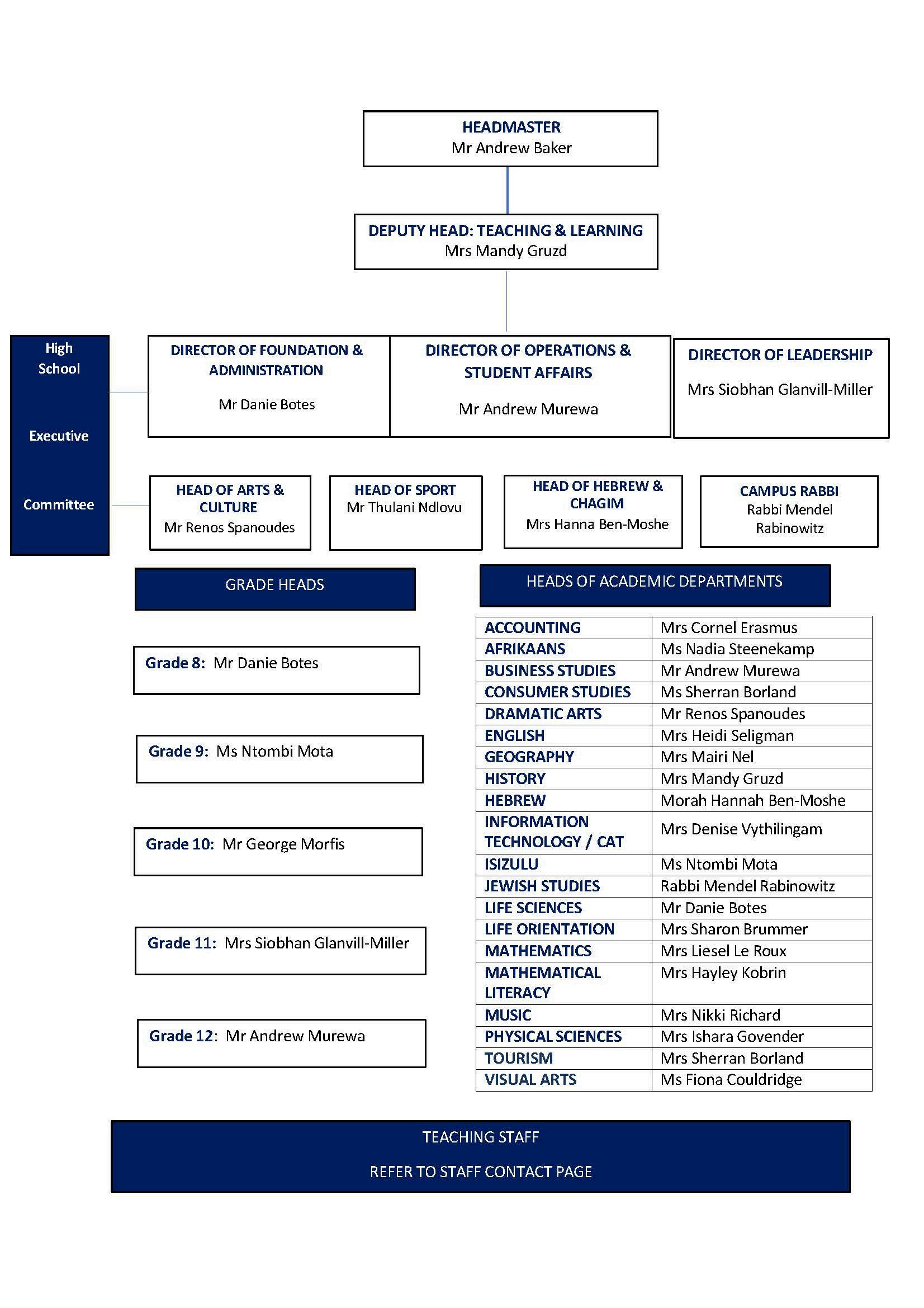

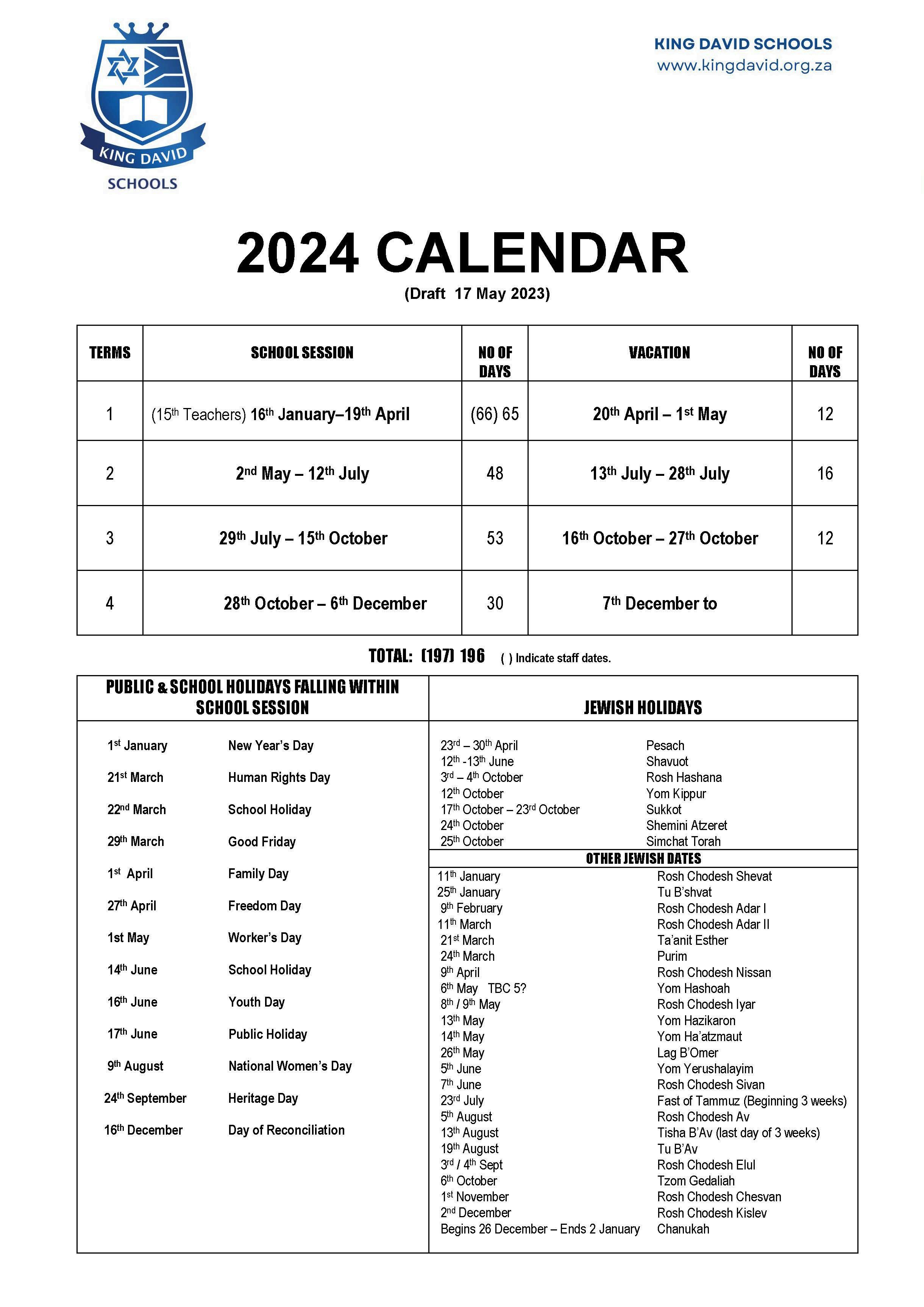


SCHOOL TIMES
Mondays 07:45 – 15:00
Tuesdays 07:45 – 15:00
Wednesdays 07:45 – 13:30
Thursdays 07:45 – 15:00
Fridays 07:45 – 14:00
OFFICE HOURS
Monday/Tuesday/Thursday 07:30 – 15:30
Wednesday 07:30 – 14:30
Friday 07:30 – 14:30
All students enrolled at King David High School Victory Park are expected to attend regular classes and normal school activities including assemblies, co-curricular activities and ex- cursions. Parents who have children who are absent on any occasion are required to call the school or send a note or an email to the relevant Grade Head explaining the absence.
GRADE HEADS
Grade 12 Mr Andrew Murewa
Grade 11 Mrs Siobhan Glanvill-Miller
Grade 10 Mr George Morfis
Grade 9 Mrs Ntombi Mota
Grade 8 Mr Danie Botes
Regular or unusual patterns of absenteeism are followed up by the Grade Head. Requests for extended leave must be submitted in writing to the Headmaster.
All students must arrive before the start of the 07:45 lesson and must proceed to their first lesson of the day. It is essential that students arrive on time for the first lesson. If a student arrives at school late and is not registered in the early morning, he/she will be marked absent. If a student arrives later in the day, he/she must go past Mrs Andrea Kattan in reception to be registered
Mrs Kattan will then give the student a Late Slip which must be given to the teacher of the lesson the student goes to first. Should a student wish to leave school early for any reason, he/she must obtain an Exeat form from the Front Office. If an appointment has been made for the school day, an email must be sent to the Grade Head indicating the date and time of the appointment.
PLEASE NOTE: No student will be signed out without this information Either the Deputy Head or The Director of Operations will sign the student’s Exeat Slip with the attached documentation as proof before leaving.


Students may NOT use cellphones during class time, assemblies, shul or meetings
Only with the express permission and instruction from a teacher, students might then be able to make use of their cellphones in lessons for educational purposes 3 Parents are asked not to phone or SMS their children during the school day
Emergency calls can be made at the office and will be relayed to your child within minutes
The school uniform is important in conveying the image, both inside and outside of the school King David has an extremely neat and smart looking uniform which demonstrates the pride we should all have in our school We know you, as parents, share this pride and we therefore would like to encourage your full co-operation in ensuring that your children arrive at school correctly dressed
Please take note of the following:
Prayers: As prayers form an integral part of the school’s ethos, it is important for students to have the correct uniform for prayers. Boys and girls are required to have their own Siddur for prayers at all times. In addition, boys are required to have Kip- pot and Tefillin at school every day.
Blazers: In the hot summer months the blazer need not be worn, except for formal occasions and when leaving the school premises on excursions. Assemblies are considered formal occasions and happen once a week on Fridays. It is compulsory that all students wear their blazers to assembly as it is a formal school gathering.
Shirts: King David has a formal school shirt. The white short-sleeve shirt must be worn in summer and the white long sleeve shirt must be worn in winter. In the case of the boys, a tie is to be worn with the long sleeve shirt. Shirts must be tucked in at all times. During winter, a plain white T-shirt may be worn under the shirt, however long-sleeved T-shirts may NOT be worn under short-sleeved shirts. Girls are not per- mitted to wear black or coloured underwear which is visible through the school shirt.
Jerseys and tops: Only the regulation school jersey may be worn. This is the black jersey with the blue and white edging. King David "hoodies” and King David tracksuit jackets are allowed. No other hoodies/jerseys are permitted. Matric students are permitted to wear their matric tops as part of the uniform. During winter months, permission is given to wear a navy or black puffer jacket.
Skirts: Girls are to wear the sky-blue official King David skirt of appropriate length. It is not permitted for the girls to roll up the skirts to make them appear shorter
Trousers: Boys are to wear the standard grey long flannel trousers when coming to school They must also wear a black belt with the trousers
Shoes: Boys have to wear black leather lace-up school shoes, and girls have a choice of black leather lace-up school shoes or school shoes with a bar No other shoes are ac- ceptable Students with severe orthopaedic problems who cannot wear traditional school shoes will be given permission to wear alternative footwear provided a letter from a med- ical practitioner is made available to the school In this case, the alternative footwear must be as modest as possible


Socks/Stockings: Boys must wear grey socks, and girls white socks or, in the winter months, black tights may be worn.
Tracksuits: Tracksuits are not part of the day-to-day school uniform and thus not per- mitted to be worn. Permission can be given to wear the tracksuit in certain circumstances when certain sports events require students to leave either slightly early or straight after school. Students may change at 2nd break into their sports kit and covered with a tracksuit. Certain circumstances surrounding Phys Ed taking place during the Life Orientation period also permits the tracksuit to be worn, but only if that period happens to be during period 1. In the case of Grade 12s doing Phys Ed during the Prayer period, then the tracksuit may be worn to school In both cases, students are required to change into full school uniform after the activity
Hair: Hairstyles must be neat and appropriate for both boys and girls
With respect to boys - hair needs to be cut in an acceptable style where the length is such that it is off the ears as well as the collar at the neck
With respect to girls – if the hair length is beyond the shoulders, then it is expected to be neatly tied up Hair is also expected to be out of the face
Shaving: Boys are expected to be clean shaven at all times Special dispensation will be given to boys for religious reasons as well as over periods of mourning
Make-up and nail polish: Girls are not permitted to wear make-up Coloured nail polish is not allowed
Jewellery: Jewellery is limited to one sleeper or plain stud in the lobe of each ear for girls. Boys may not wear earrings. Nose studs/nose rings are strictly forbidden as are studs in eyebrows, tongues or any other facial piercing (except as described for the ears). The covering of a piercing with plaster is also not permitted. Students may wear one small Chai or Magen David inside their shirts. No bracelets, other than medic-alert bracelets may be worn. No rings on fingers are to be worn.
Tattoos: No visible tattoos, permanent or non-permanent, are permitted.
Regular communication with parents is vital, and as part of this process a newsletter is distributed by e-mail every Friday. The newsletter provides information of a general na- ture, but also informs parents of the academic, sporting, and cultural events in the week ahead. Kindly ensure that the office has your current e-mail address.


The new Academic Support Timetable for Term 1 has been issued. All Grade 8 - 12 students are encouraged to make appointments to meet their teachers online should they need additional support. These sessions will be appointment-based at a time that is convenient for both teacher and student.
Assessments are a vital component of the school’s educational philosophy. Regular testing of smaller sections of work has proven beneficial in preparing students for mid-year and final examinations.
Further class tests are scheduled throughout the term, and these dates will be published in the Term Calendar. Any student who is absent for a Standarised Test must please inform the school as soon as possible. The student is expected to liaise with the subject teacher concerned to set an alternative date for the test.
The examination dates for 2024 are:
June Examinations: 24 June - 12 July 2024 No Script Checking
Preliminary Examinations: Study Day 19 August 2024
20 August - 18 September 2024
IEB Final Examinations:
Life Orientation CAT 10 September 2024
Life Sciences PAT 11 September 2024
Visual Art Practical 25 - 29 September 2024
NSC Final Examinations * Study Break 9 - 14 October 2024
15 October - 29 November 2024 (Further Studies Subjects, CAT, IT Practicals in early period)
*Timetable to follow later in the year.
Students are required to be present at school for all examinations The school will not give students permission to miss examinations for any reason. If students are absent for an examination, the school must be informed as soon as possible. A doctor’s certificate must be handed into the Deputy Head on their return to school.
We are bound by IEB rules and regulations.
Reports are issued at the end of a cycle. An Academic Parents' Evening will follow.





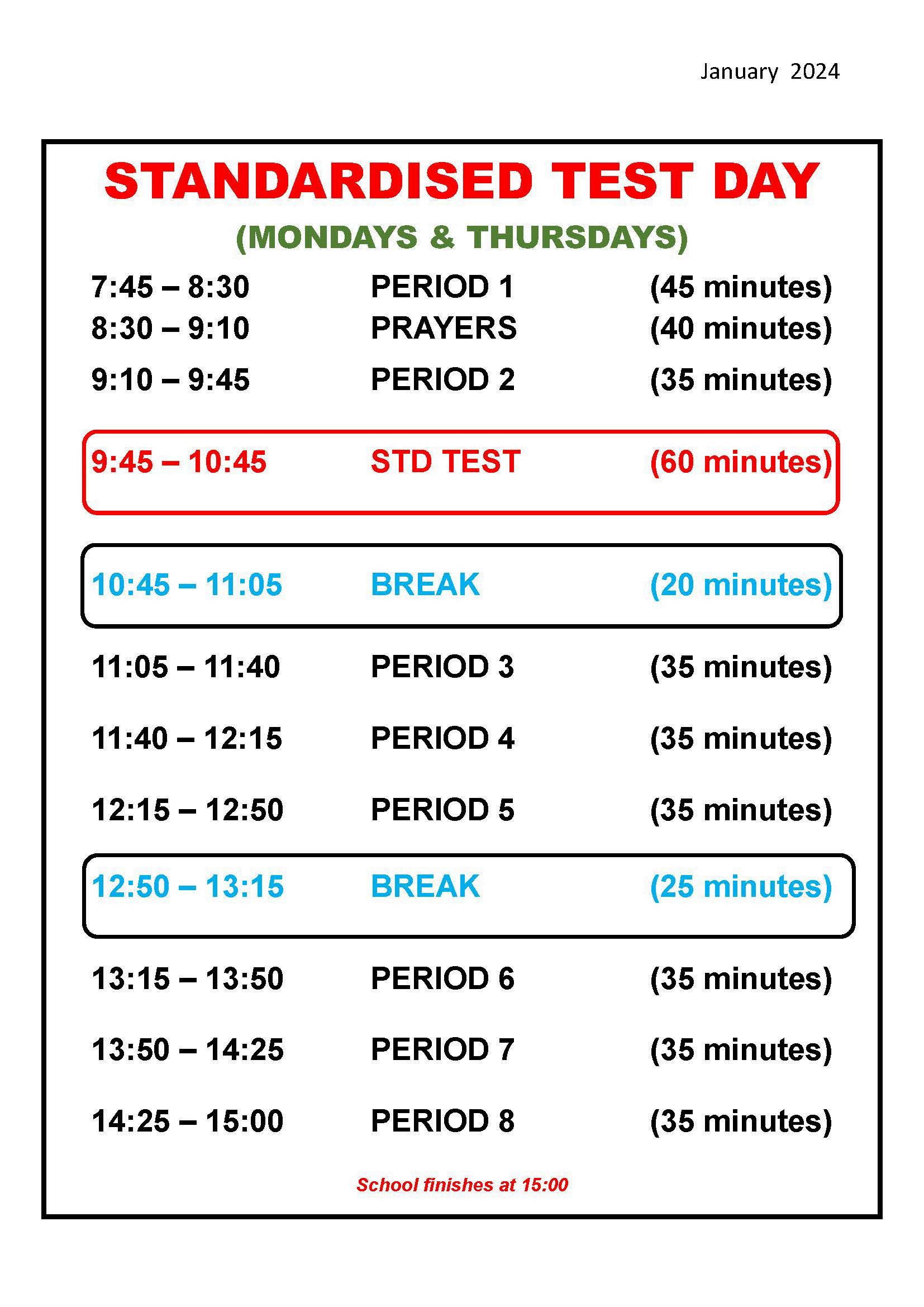


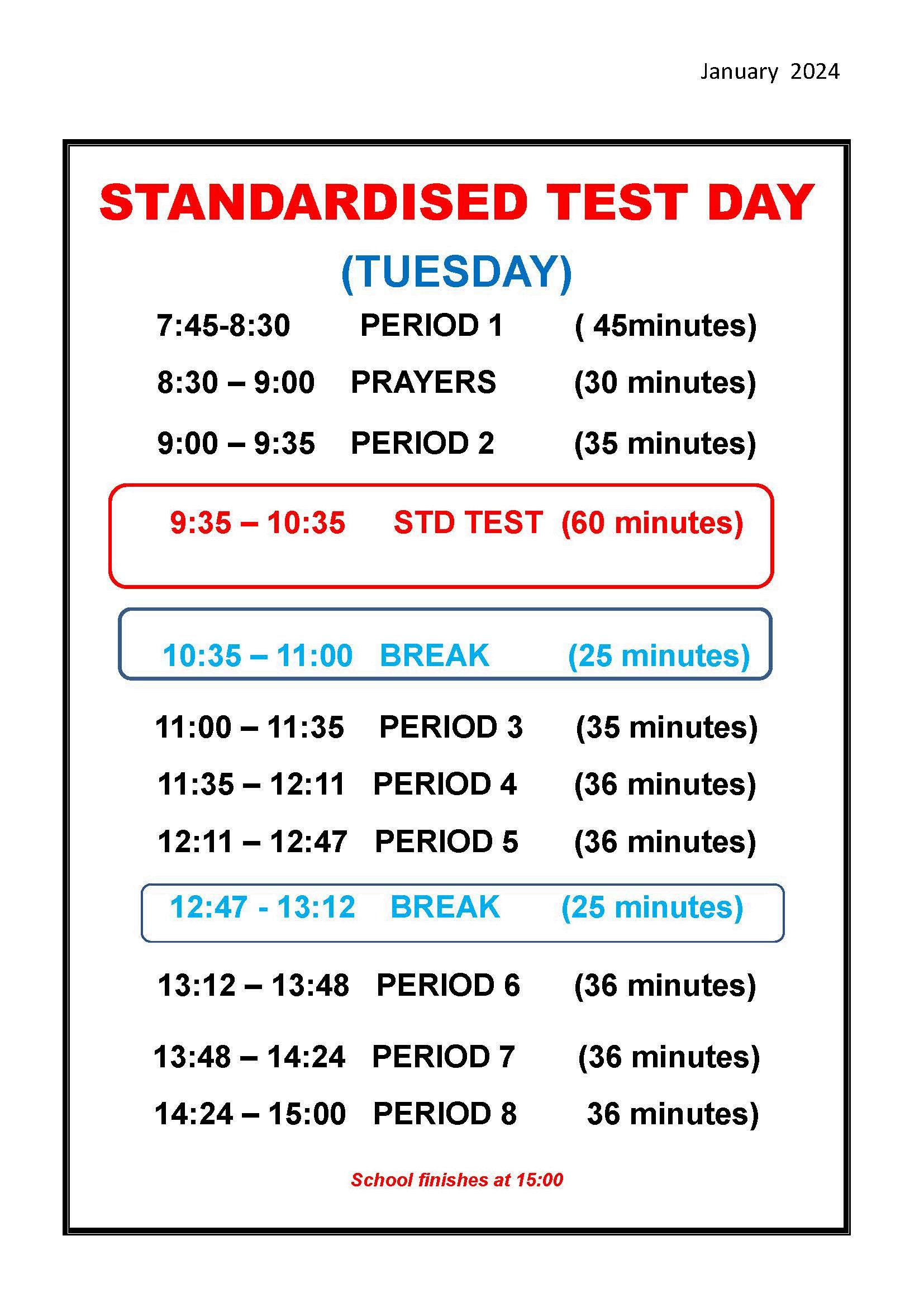


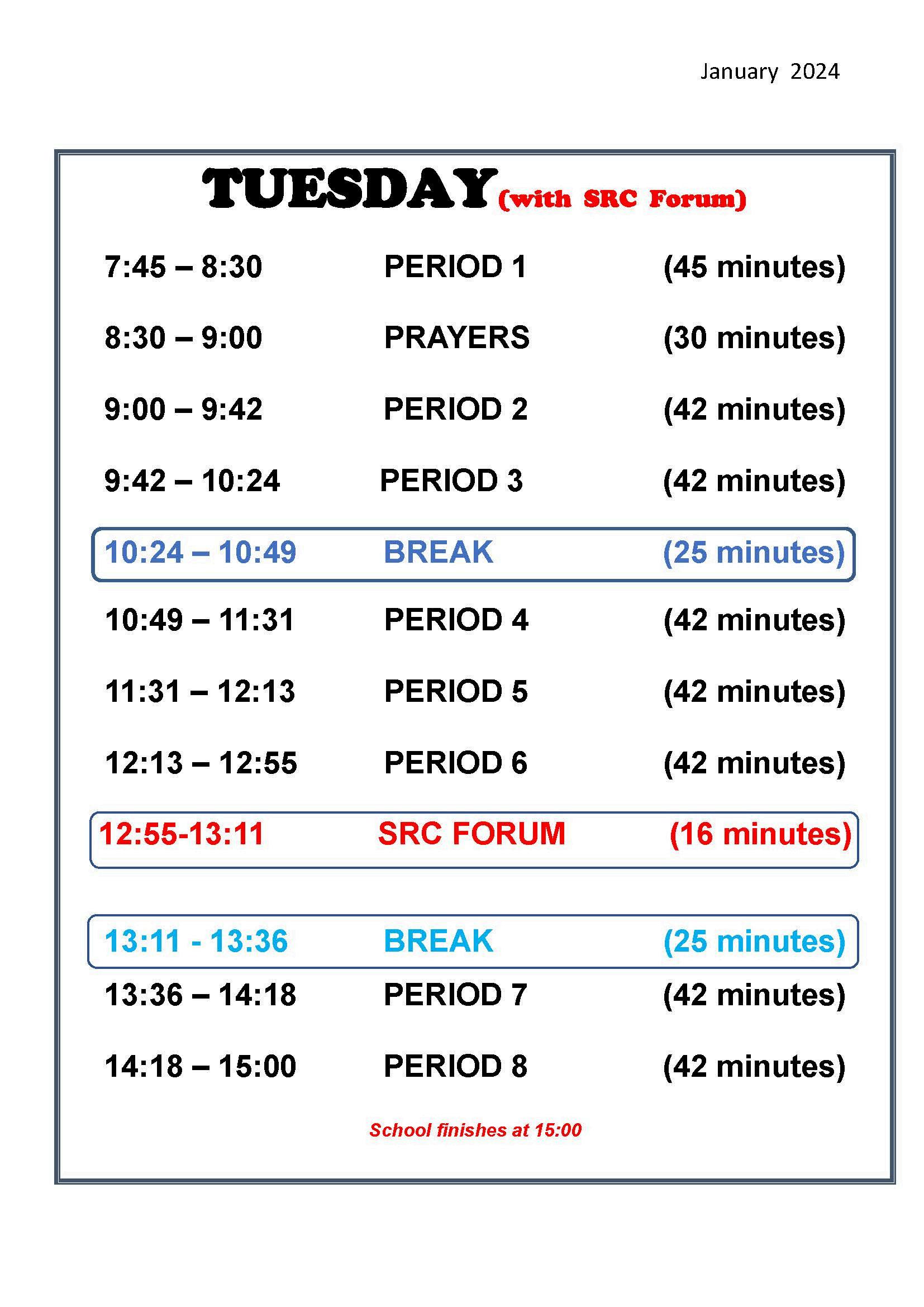


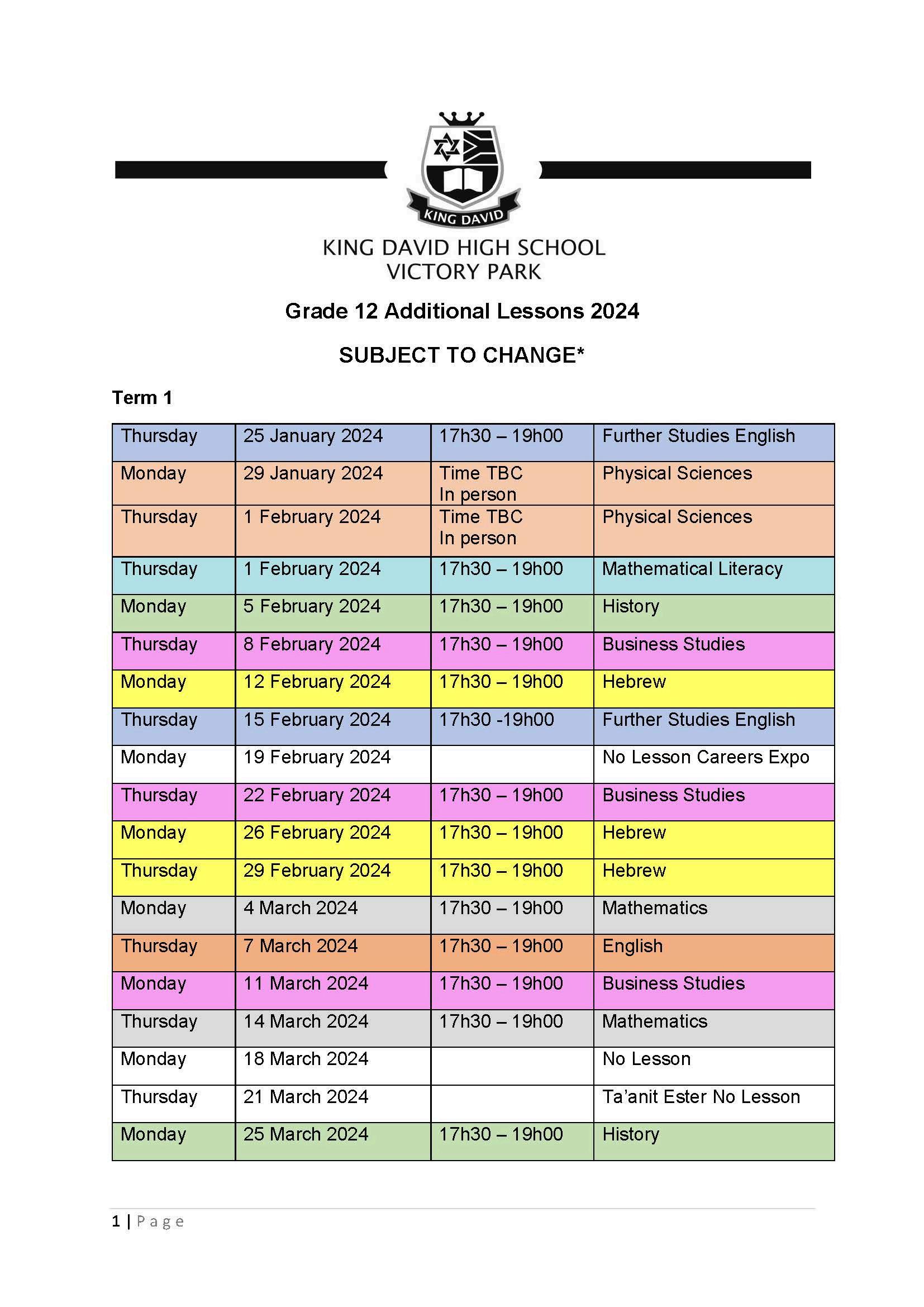


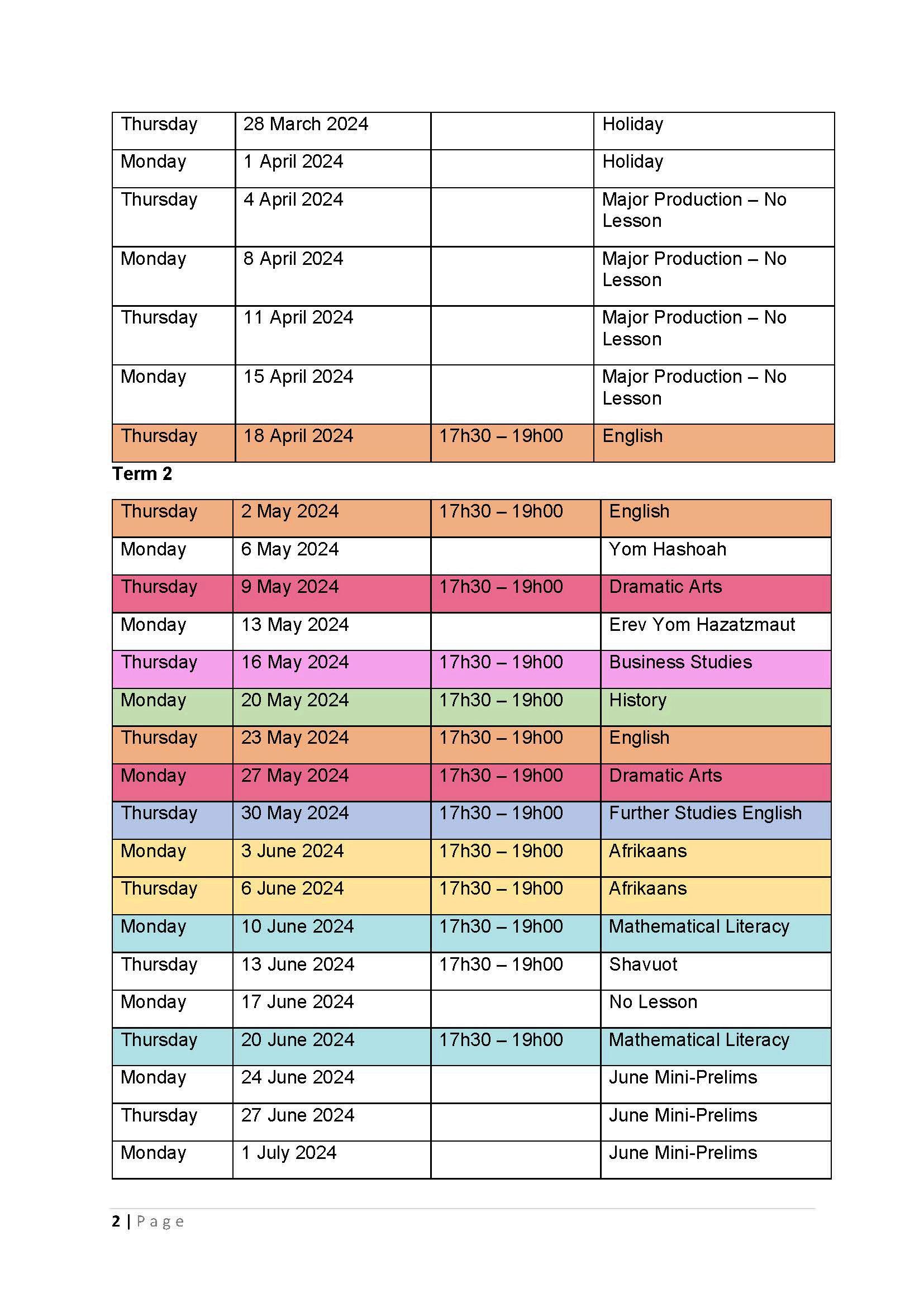


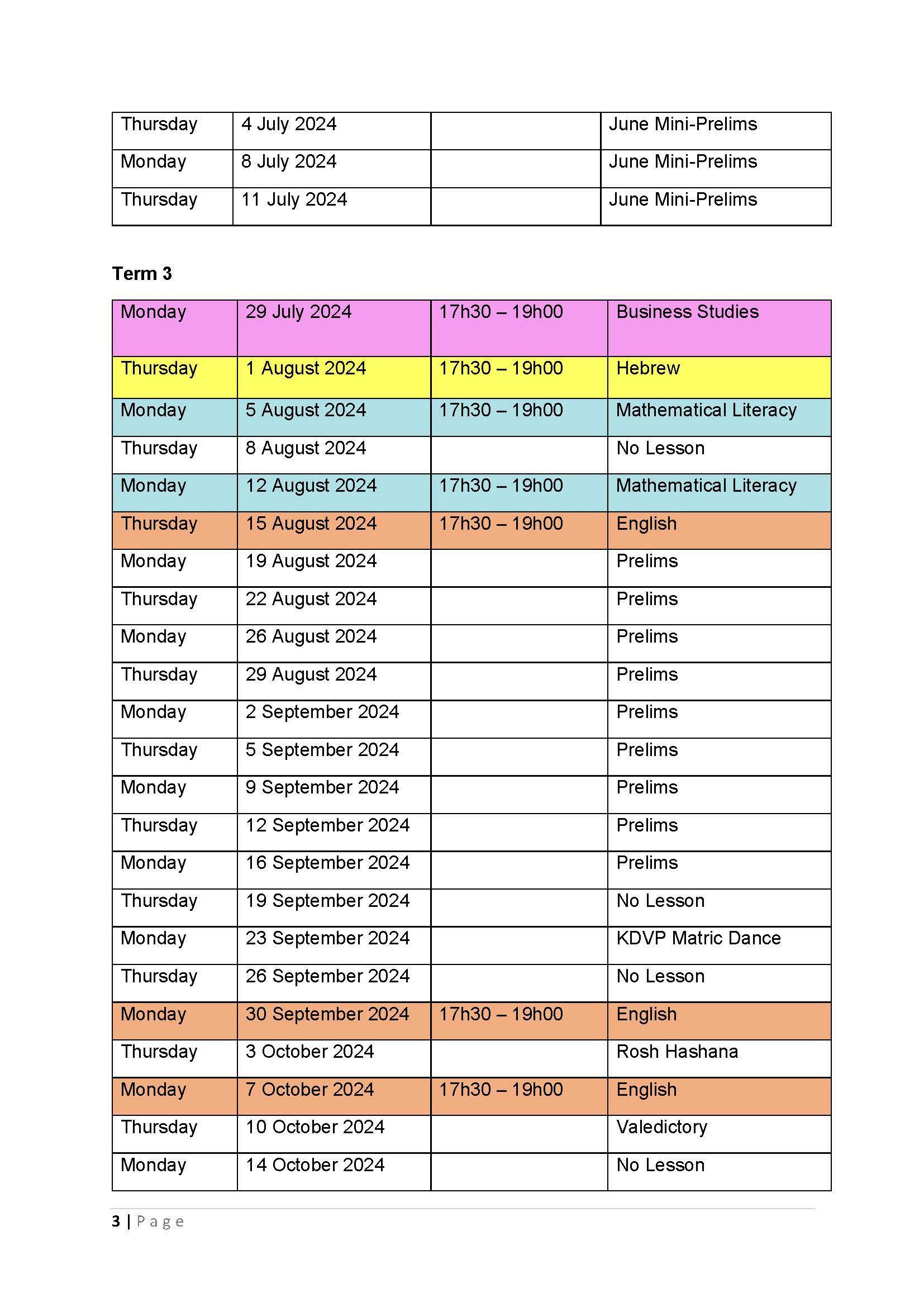
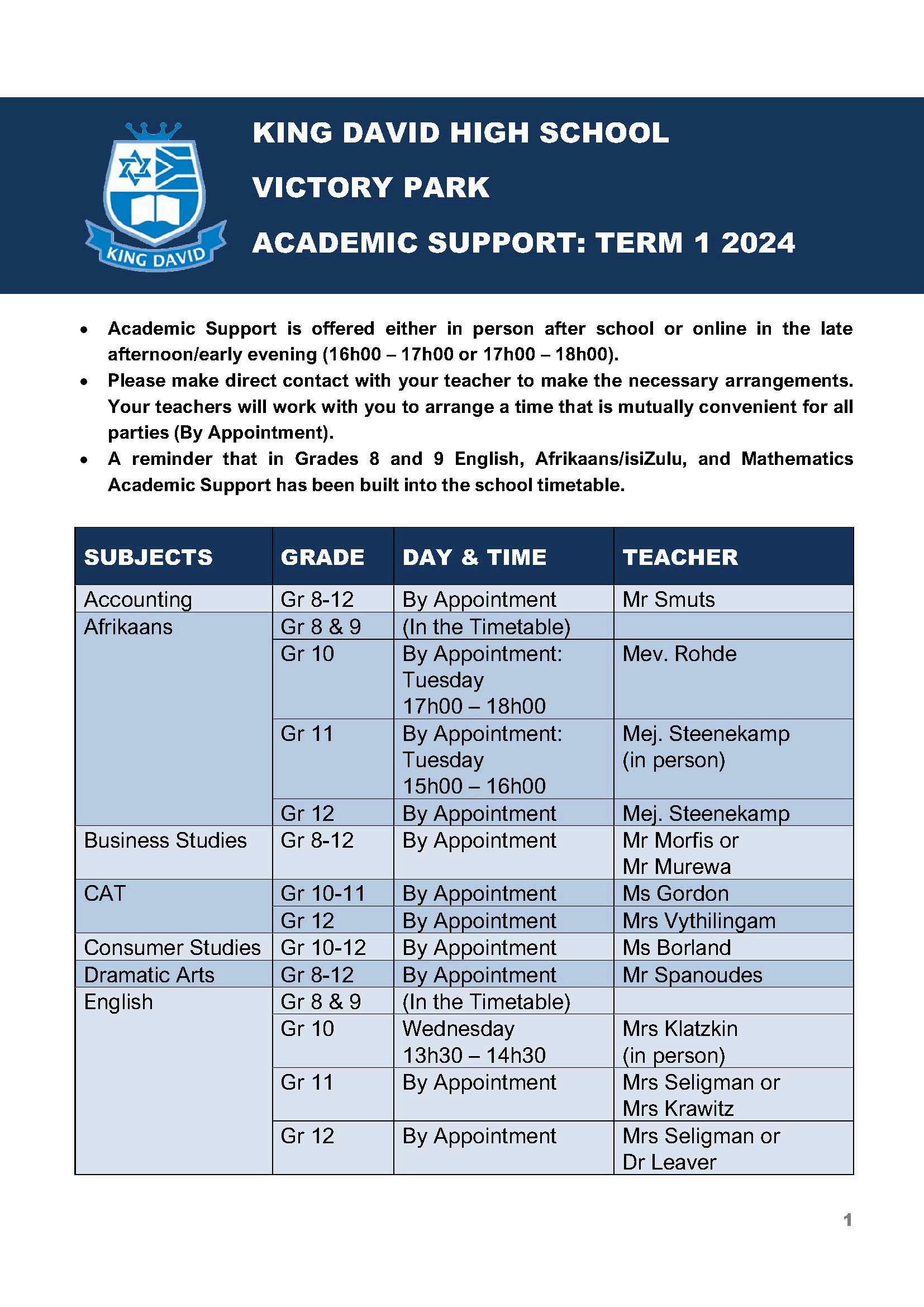


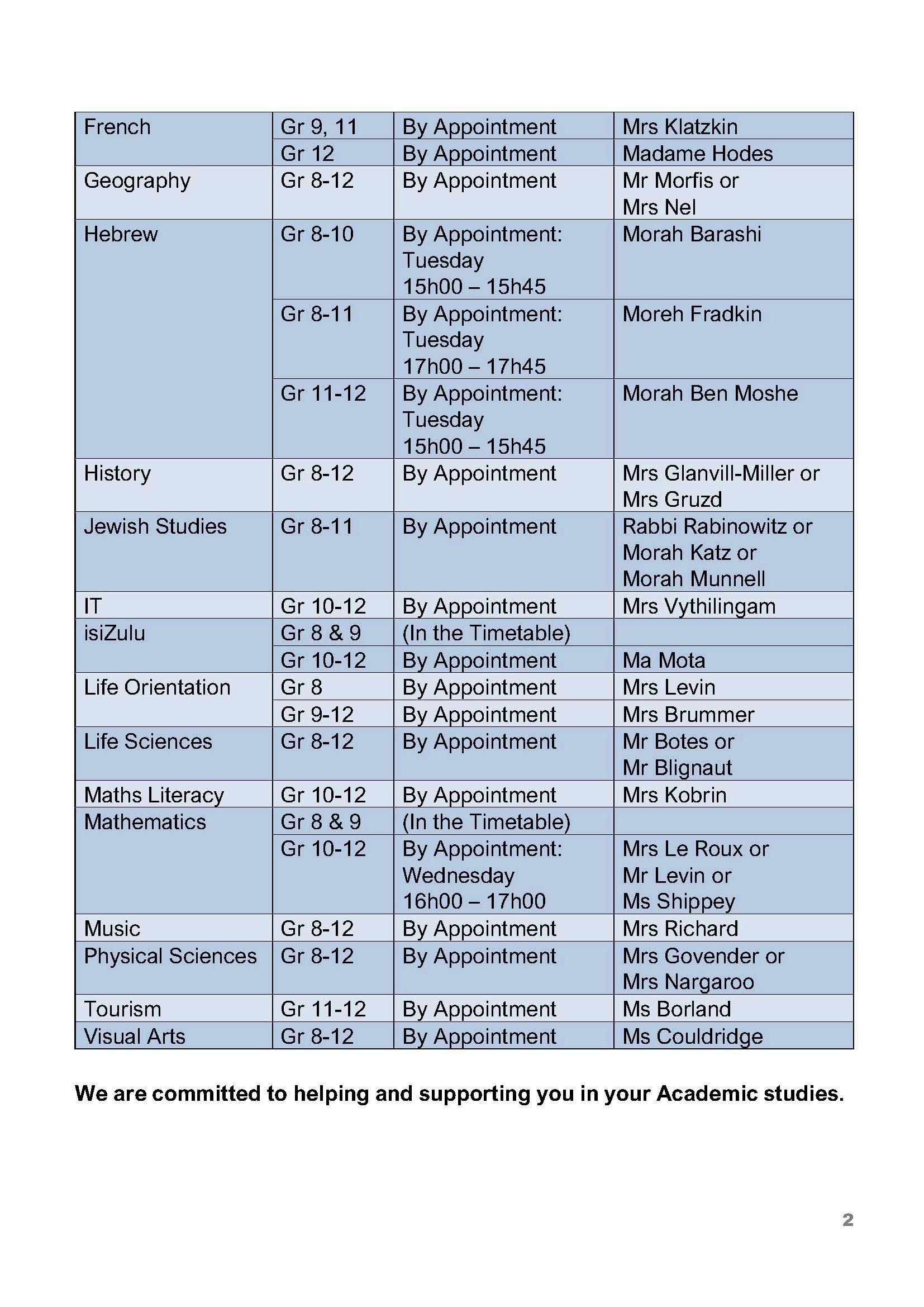


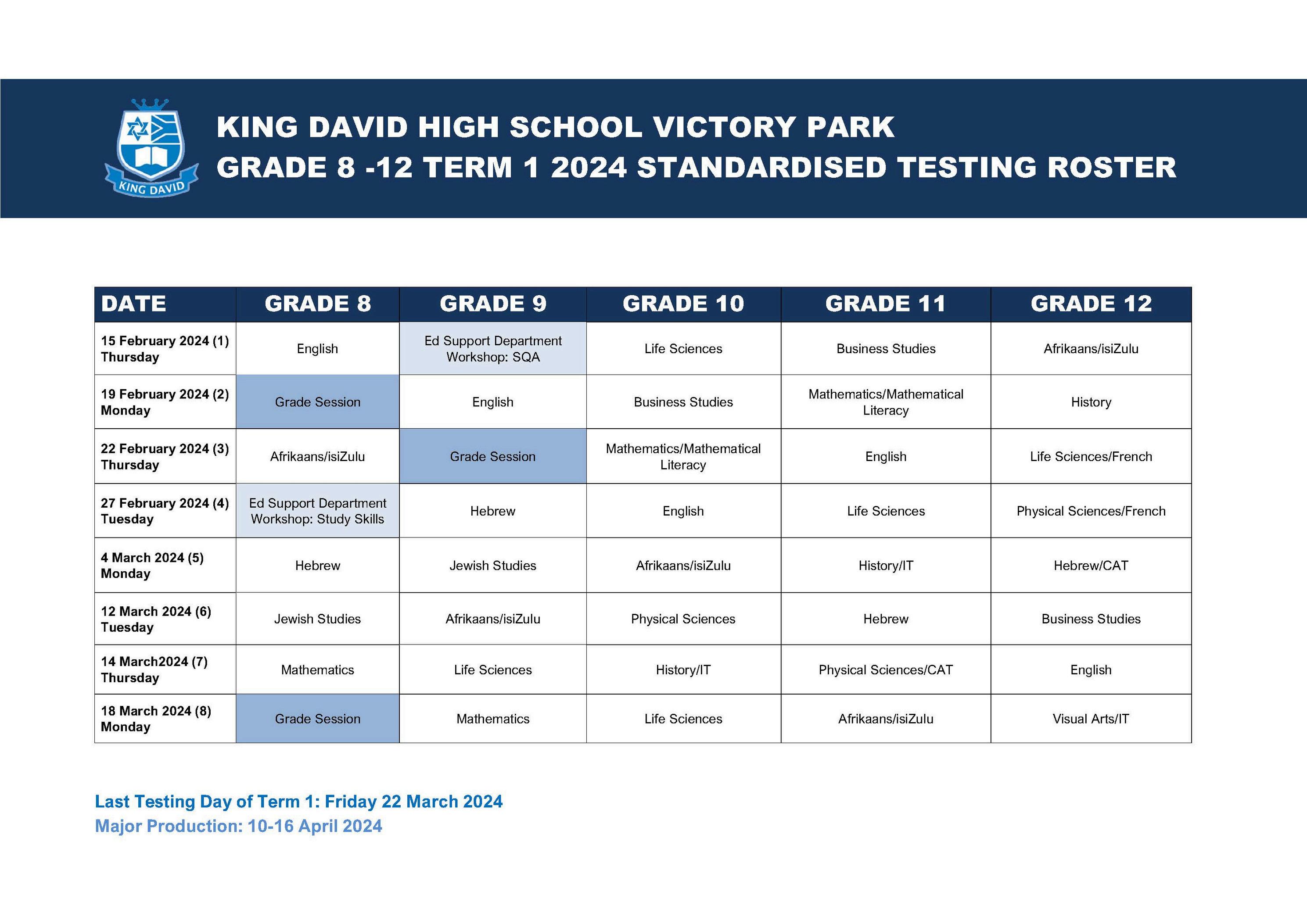


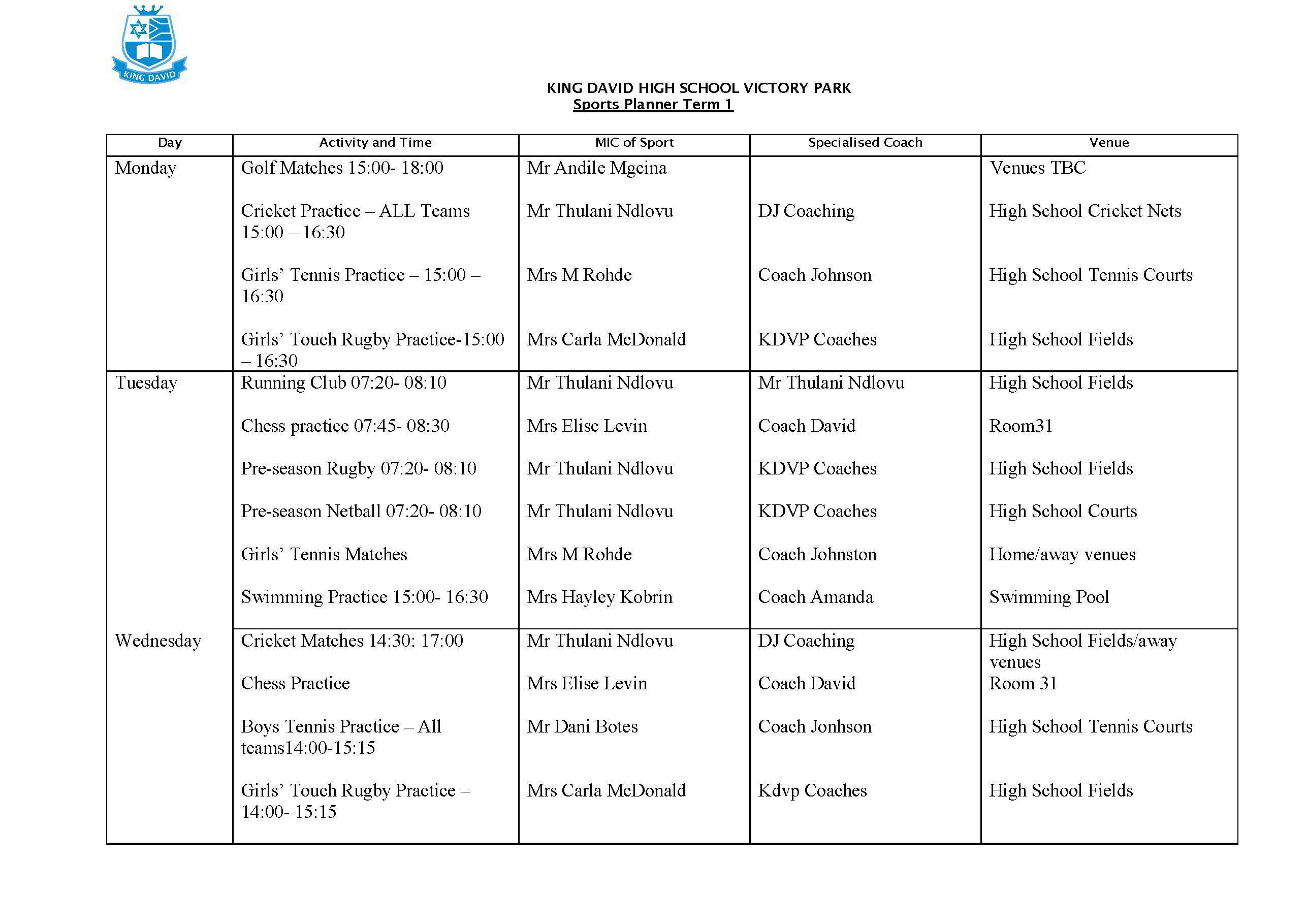
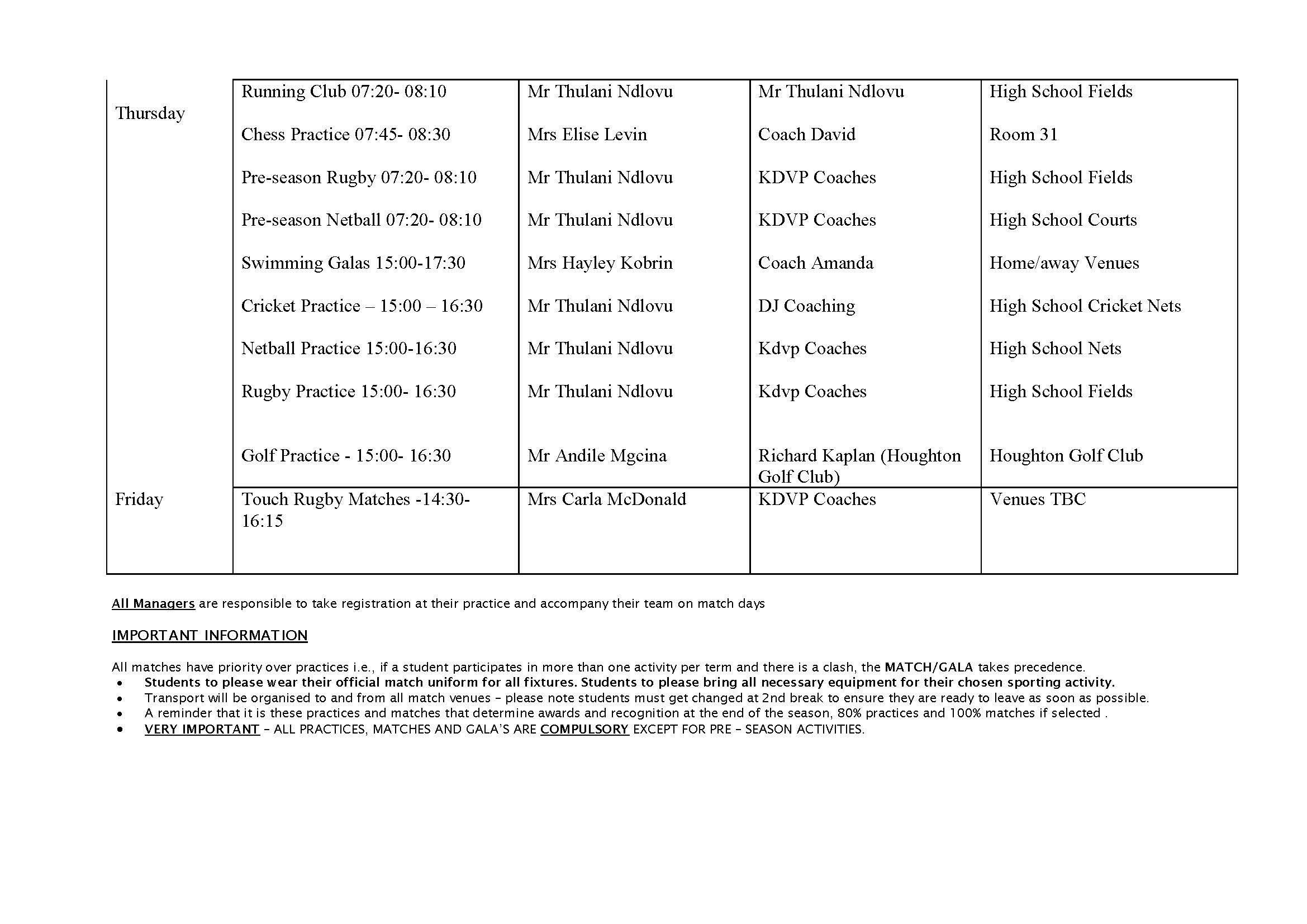


Parents are requested to diarise the important dates and assist their children with timeous preparation for tests and assignments
NB: Some dates are subject to change!
Grade 12 Parents Information Evening 24 January 2024
Prize-Giving Awards Assembly 2 February 2024
Grade 12 Mid-year Examinations 24 June - 12 July 2024
Dramatic Arts ESIT Completed 30 June 2024
Preliminary Examinations 20 August - 18 September 2024
LO CAT Part B Examination 10 September 2024
Life Sciences PAT Examination 11 September 2024
Subject Portfolios ready for Regional Moderation 15 September 2024
Matric Dance 23 September 2024
Visual Arts Practical (4 Days) 25 - 29 September 2024
Valedictory Prize-Giving Ceremony 10 October 2024
Further Studies English Examination 15 October 2024
CAT Paper 1 Practical 16 October 2024
Further Studies Mathematics Examinations 22 Ocotber 2024
IT Paper 1 Practical 23 October 2024
IEB Final Examinations 15 October - 29 November 2024


The minimum requirements for entry into Degree studies are as follows:
50% or more in 4 subjects; this excludes Life Orientation.
40% or more in English
30% or more in 2 other subjects.
Each university has its own entrance requirements Even if a student meets the minimum entrance requirement, there is no guarantee that he/she will be accepted Some faculties have specific requirements over and above the minimum Academic Points Score (APS), eg Portfolio, Interview The universities require all students to apply online using their final Grade 11 results
* NSC = NATIONAL SENIOR CERTIFICATE
**APS = ADMISSION POINTS SCORE
Maths is compulsory for all numerate programmes in Engineering and Built Environment, Commerce, Law and Management, and Science and Health Science Maths Literacy will be accepted by Law, Education and Humanities except Speech and Language Pathology.


In order to apply for all a Bachelor’s Degree, the minimum admission requirement is a National Senior Certificate (NSC), as certified by Umalusi, with an achievement rating of 4 (50-59%) or better in four subjects chosen from recognized NSC subjects
* NSC = National Senior Certificate **APS = Admission Points Score
Life Orientation must be divided by 2 to calculate the APS rating.
The minimum admission requirement for the Bachelor’s degree is a National Senior Certificate (NSC) with an achievement rating of 4 (Adequate Achievement, 50 - 59 %) or better in four subjects chosen from a designated list of subjects.


The percentages achieved in National Senior Certificate examinations will be allocated an admission score equal to that percentage.
The sum of six subjects, excluding Life Orientation, but including English and any required subject(s), for the relevant programme, is considered when deciding on admission.
Results below 40% for any subject do not attract a score.
In the faculties of Engineering & the Built Environment, and Health Sciences, the NBT score forms part of the APS.
In the Faculties of Engineering & the Built Environment and Science, the Mathematics Paper 3 contributes to the APS
In order to apply for a Bachelor Degree, the minimum admission requirement is a National Senior Certificate (NSC), as well as the minimum requirements for the relevant programme. The calculation of an Admission Point Score (APS) is based on the achievement in any 6 recognised NSC subjects by using the NSC seven–point rating scale. Life Orientation may not be used for calculating the APS.


It is students' responsibility to check which component/s of the NBT is required by the University they are applying to.
Please take note that students applying for selection programmes must write by the following cut off dates:
University of Johannesburg
University of Pretoria
No NBTs required for 2024 intake
Applications open 1 April 2024 Apply early
No NBTs required for 2024 intake
Applications open 1 April 2024
Applications close as they reach capacity so it is important to apply early
University of Cape Town
UCT requires NBTs for all undergraduate faculties
Final date to write the NBTs is mid October 2024 for all faculties except Health Sciences which requires you to write NBTs by 31 July 2024.
Applications open 1 April 2024
Do not wait until the closing date. Apply early. You CAN apply before you have written your NBTs
University of Witwatersrand
WITS requires NBTs for Health Sciences and Speech-Language Pathology and/or Audiology by mid August 2024. NBTs also required for Sciences by 31 October 2024. Applications open 1 March 2024 Apply early You CAN apply before you have written your NBTs


NBT Preparation Workshops through Advantage Learn (Voluntary)
King David Victory Park has secured two training dates with ADVANTAGE LEARN to assist Grade 12s with preparing for the National Benchmark Test These workshops are being offered on Sunday 5 May 2024 and Sunday 12 May 2024. The breakdown is as follows:
Sunday 5 May 2024 MAT (Numeracy) 08h00 - 12h00 & 13h00 - 18h00
Sunday 12 May 2024 AQL (Literacy) 08h00 – 12h00
These will be held at King David High School Linksfield. Details and instructions on how to book for these workshops will follow.
CAREERS EVENING WILL TAKE PLACE AT SANDTON SHUL HALL, LONGDON ROAD, MORNINGSIDE ON MONDAY 19 FEBRUARY 2024 FROM 18H00-20H00. PARENTS AND STUDENTS ARE WELCOME.


External Assesment
B. REQUIREMENTS
1.EXTERNAL ASSESSMENT (FINAL EXAMINATION)
marks
Both papers are written on the same day as the same knowledge is required by learners for both papers.
Paper 1: (2 hours) (200 marks)
This paper mainly assesses skills, where there is not a lot of time needed to read through information or to think of innovative solutions to problems.
Paper 2: (2 hours) (100 marks)
This paper assesses theory, analysis, interpretation and problem solving. It assesses sections that require more time to read through and analyse information.
2. INTERNAL ASSESSMENT (PORTFOLIO) (100 marks)
Preliminary Examination - Paper 1 and Paper 2 30 -Three tests (15% each) 45 -One task – Project 25


External Assesment
Internal Assessment Portfolio
A. MEANS OF ASSESSMENT
B. REQUIREMENTS: 2023
1.1 EXTERNAL ASSESSMENT (FINAL EXAMINATION)
Paper 1: READING, VIEWING, POETRY AND LANGUAGE (2½ hours) (100 marks)
This paper focuses on the ability to make meaning of texts. Language and grammar questions will therefore be directed to the function of and reasons for using certain grammatical forms or language conventions across a range of texts. A variety of text formats will be used.
This paper will include texts that look for the following skills:
Section A: Comprehension (30)
Section B: Summary (10)
Section C: Poetry: seen (20) and unseen (10) (30)
Section D: Language (30)
Paper 2: LITERATURE AND WRITING (EXTENDED) (2½ hours) (100 marks)


This paper focuses on the prescribed novel (Donker Web) as well as the ability to create meaningful texts across a wide variety of formats and for a range of purposes, contexts and audiences.
Section A: Literature (novel) (70)
Learners will be required to write essays/ paragraphs as well as to answer contextual questions on the novel.
Section B: Transactional writing (30)
Learners will be required to write two pieces. There will be no choice. (1x20 marks) (1x10 marks)
2.1 INTERNAL ASSESSMENT(PORTFOLIO) (100 marks)
Section A: Process Essay Writing (30)
Section B: Common Assessment Task (20)
Section C: Literature: 3rd Genre Film (20)
Section D : Tests (At least three tests reflecting different skills) (10)
Section E: Preliminary Examinations (Paper 1 and 2) (20)
2.2 ORAL AND AURAL ASSESSMENT (100 marks)
This Learning Outcome will be assessed internally and moderated internally as well as externally
The final mark will comprise of:
Reading aloud (prepared and unprepared) and conversation (20)
Prepared speaking and conversation (20)
Conversation / informal speaking (20)
Listening comprehension (20)
Total 80 convert to 100


A. THEME
The theme for this year is Retailers/Shops. All teaching, learning and assessments will relate to this theme You must gather current affairs on a regular basis in order to apply it where needed
1
Examination: (3 hours) (300 marks)
Section A (50 marks)
Short questions consisting of multiple choice, true / false, choose the correct answer style questions will be set. These vary from one mark per question to approximately 3 marks per question. All content to be covered in order to relate to this section.
Section B: (150 marks)
Longer questions will be set, on a case study. Mark allocation will vary from 1 mark per question to approximately 20 marks per question. No choices are given. All content to be covered in order to relate to this section.
Section C: (1 hour) (100 marks)
One Business Report of 50 marks, will be set, based on a case study No choices are given All content to be covered in order to relate to this question The question is marked according to a rubric Problem solving and current affairs are important for this question


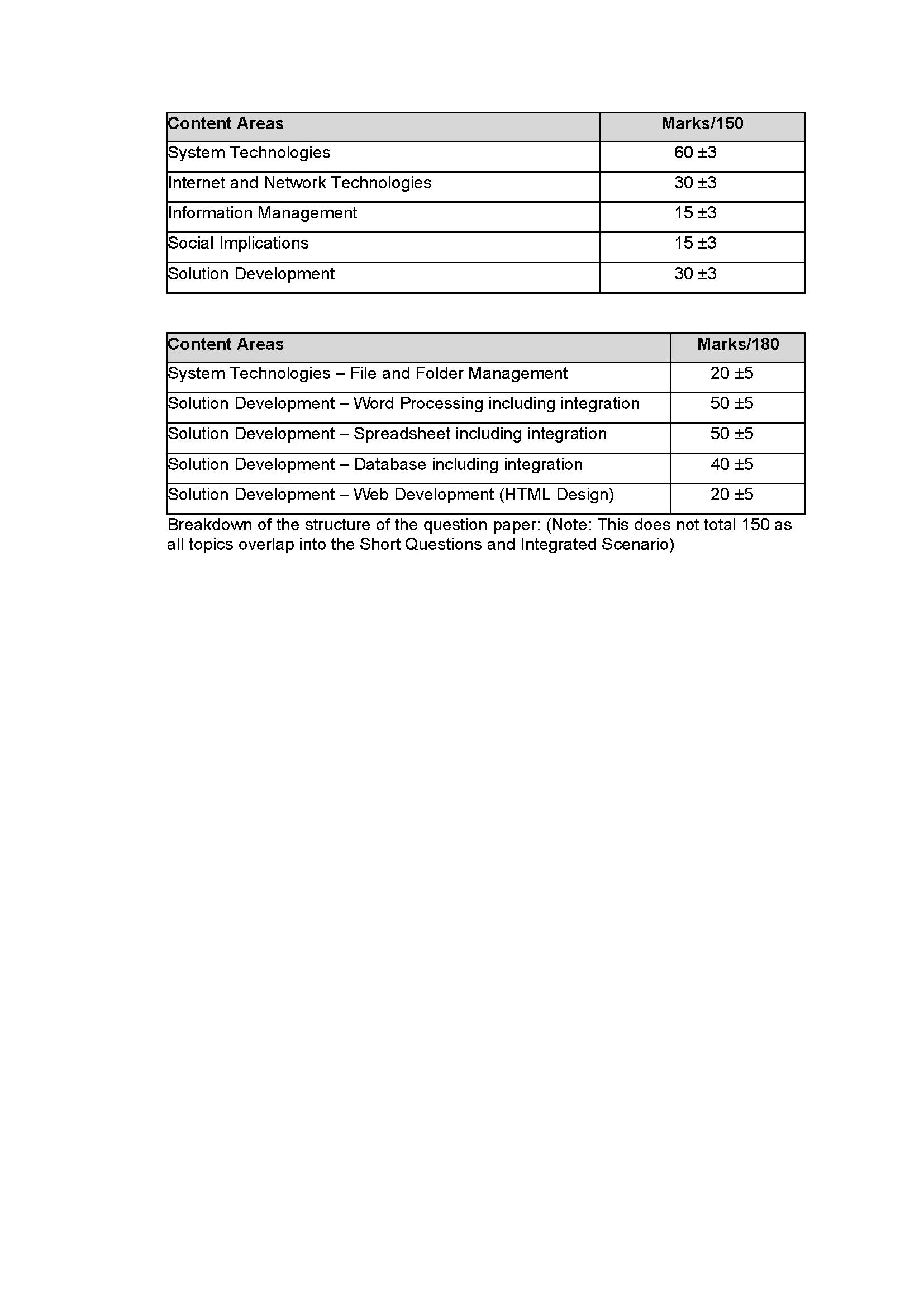


Paper 2: THEORY (3 hours) (150 reduced to 100 marks)
The purpose of Paper I is to assess the operational knowledge of Hardware,
Software and Networking in depth, the knowledge and understanding of the theoretical aspects of Integrated end-user computer application skills and knowledge in problem solving and Information Management.
The content covered in the above section is:
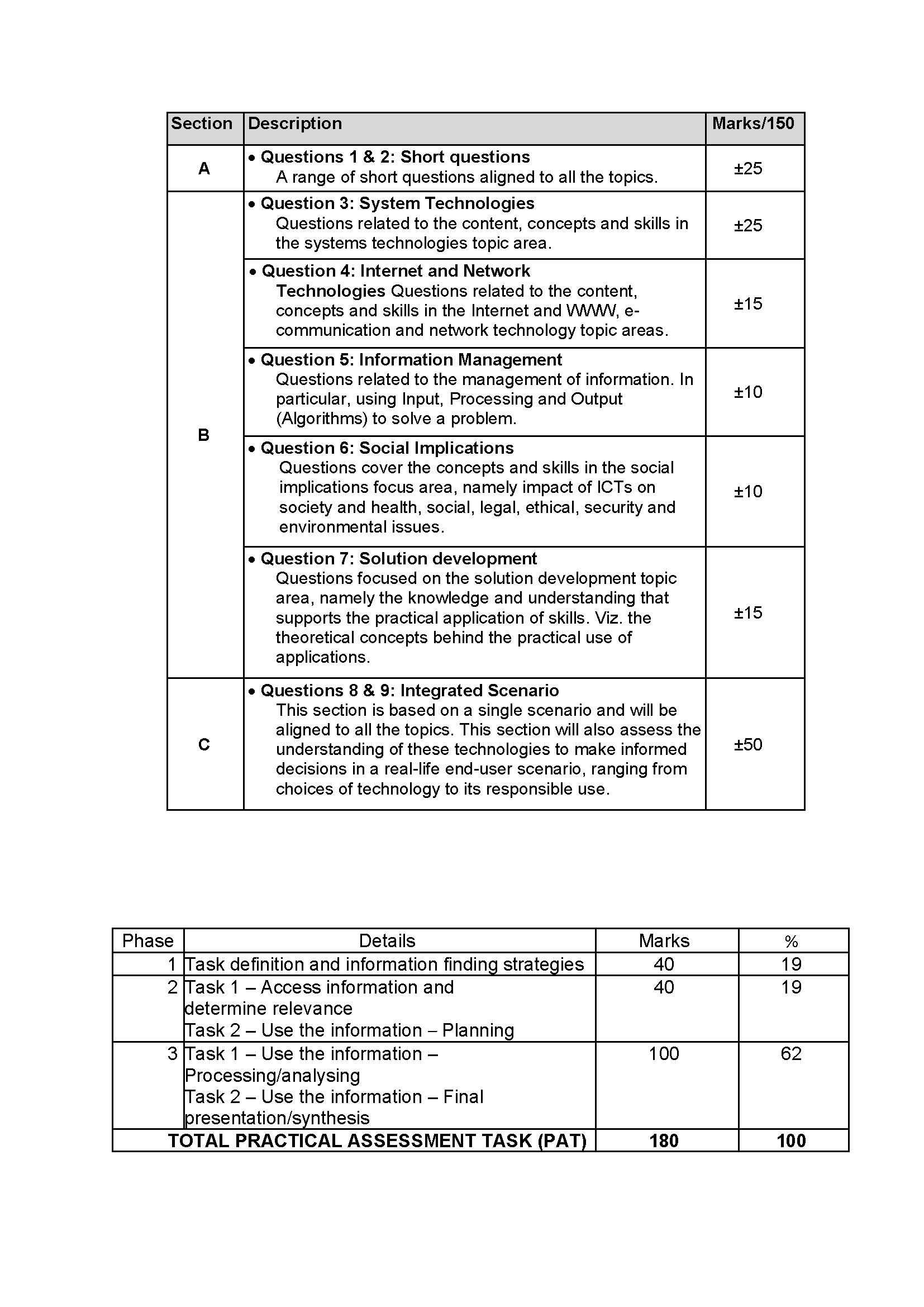



2. PERFORMANCE ASSESSMENT TASK (PAT) (180 marks reduced to 100 marks)
This is an integrated research (finding, accessing, retrieving, processing and managing information) and presentation (end-user skills) project using at least three of the four application packages: word processing, spreadsheets, databases and a fourth package of choice, e.g. web design, movie editing or presentation package. This project should allow for independent thought and creative thinking.
3. INTERNAL ASSESSMENT (SBA)
Table 1: Requirements for School Based Assessment (SBA)
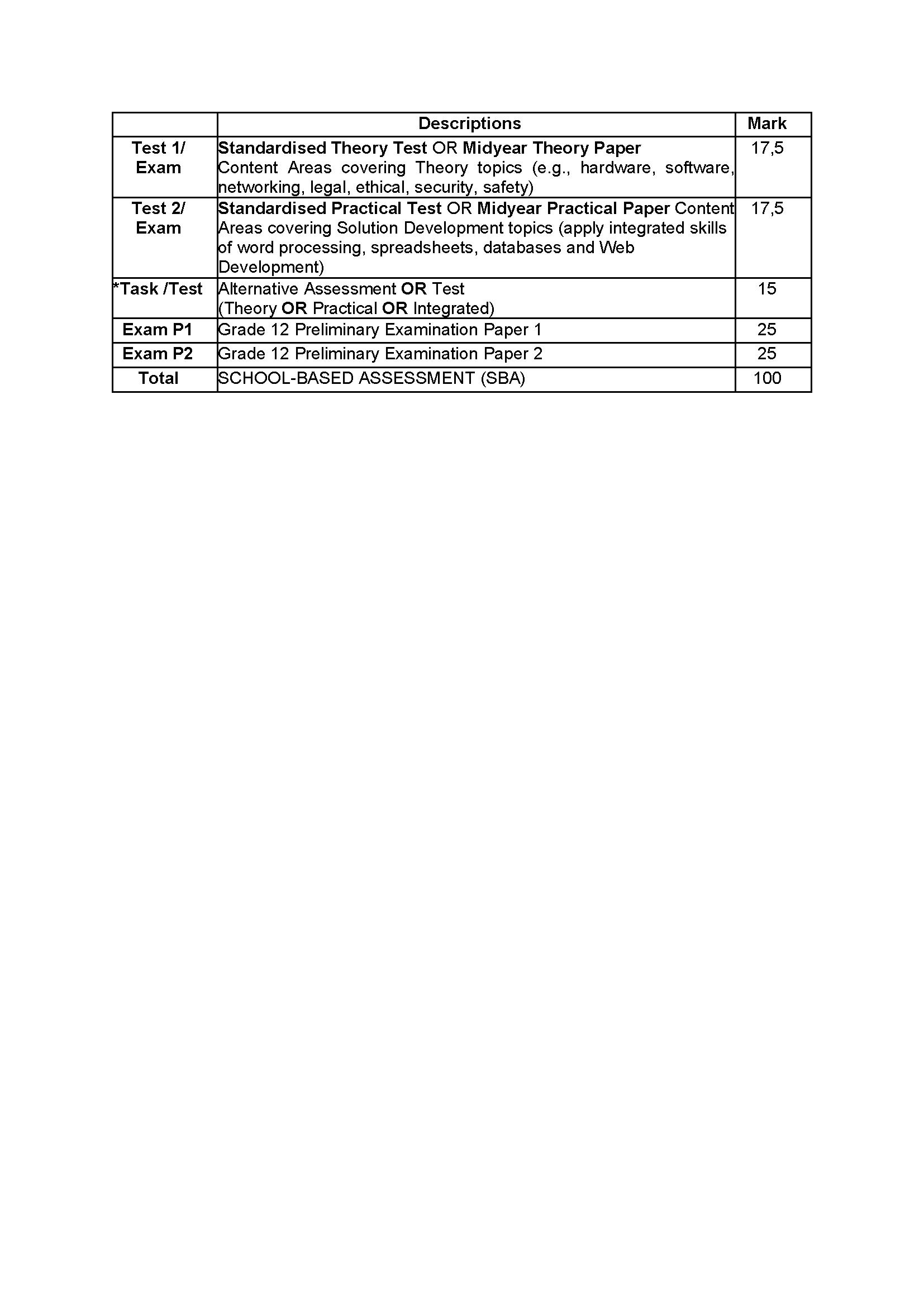


External examination
Duration: 3 hours
Total: 200 marks
There is no choice. All of the questions are compulsory.



(PAT)
Component
One practical assessment task to be moderated externally
SBA REQUIREMENTS (PORTFOLIO)
Weighting
100 marks
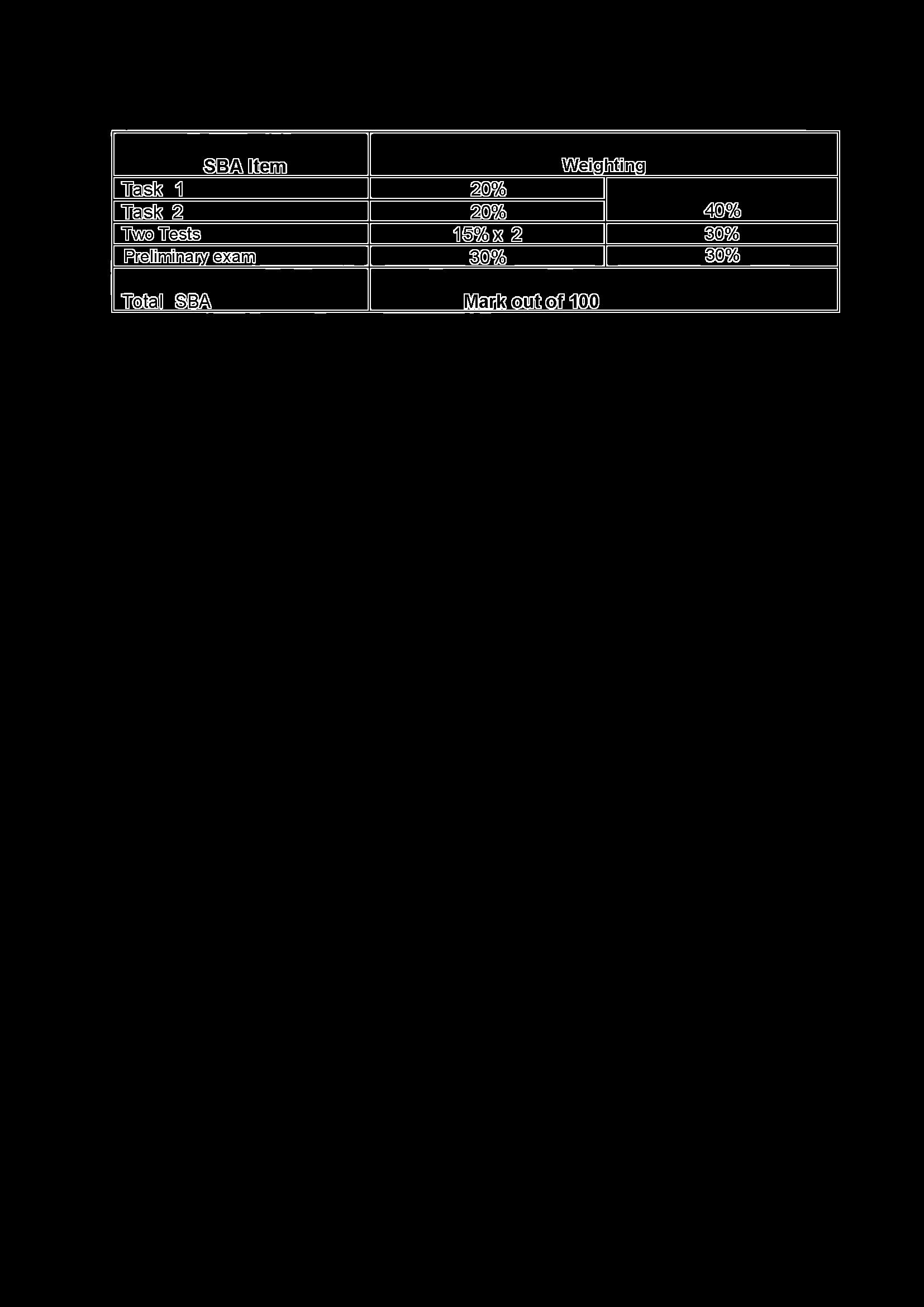
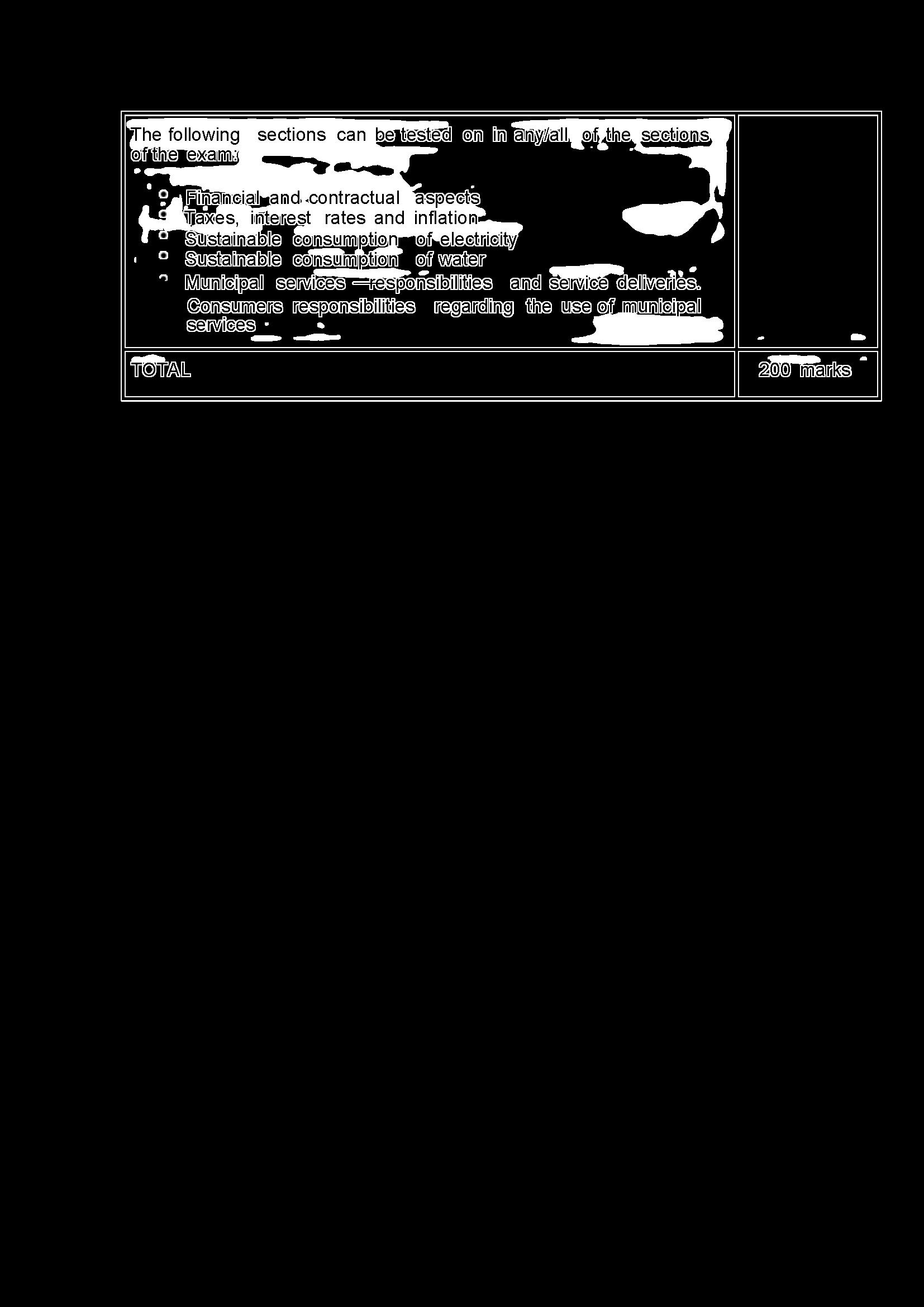


1.
Continuous Assessment Tasks - 100 Marks (25%)
- Integrated Practical Tasks (3 x 25 = 75)*
- Theoretical Internal Assessment (3 Tests x 10 = 30) + (Prelim 15) = 45*
75+45 = 120 converted to 100 Marks) *
2. External Assessment Tasks - 300 Marks (75%)
- Practical Assessment Task (Part A 40 + Part B 40 = 80 Marks converted to 60)
- Final Theory Exams 3 Hours (3 Sections x 40 = 120)
- Final Prac Exam Online Submission (3 Pieces x 40 = 120) (60+120+120=300 Marks)*
- Continuous Assessment + External Assessment 100 + 300 = 400 Marks
B. REQUIREMENTS
GRAND TOTAL = 400*
PORTFOLIO SECTION 1 INTEGRATED PRACTICAL TASKS X 3
Each 20 Marks Practical Recorded Performance + 5 marks
Theoretical x 2 = 75 Range of Skills, Genres, Styles; IPT (1)
Monologue (2) Dialogue / Scene and (3) Own Choice (Physical Theatre, Movement, Musical Theatre, Poetry, Prose, SelfWritten, Stand-up Comedy)
PORTFOLIO SECTION 2 TESTS X 3
[Each (Minimum Mark of 40) converted to 3 x 10 = 30 marks]; Theory Sections + PRELIM 3 Hour Exam Theory (120 marks converted to 15)
Eclipsed Post 1994 SA Theatre (40).
Sophiatown Pre 1994 South African Theatre (40) Angels in America Post Modernism ( 40)
PORTFOLIO SECTION 3 PRACTICAL ASSSESSMENT TASK (PAT)
Part (A) Class Group / Individual Performance Tasks (40) + Part B (40) Written Theory Exam Mid-Year
3 FINAL PRACTICAL LIVE AND RECORDED EXAM PERFORMANCE PIECES MONOLOGUE (40)
DIALOGUE / SCENE (40) OWN CHOICE (40) = 120
1 FINAL THEORY PAPER 3 Hour Exam as detailed in PRELIM above 40 + 40 + 40 = 120 (1 x Essay) = 120
25 X 3 = 75 marks
(30) + (15) = 45 marks (75 + 45) = 120 120 converted to 100*
(40) + ((40) = 80 marks 80 converted to 60*


A. MEANS OF ASSESSMENT
External Assessment
Paper 1: 3 hours for 100 marks
Paper 2: 3 hours for 100 marks
Internal Assessment
SBA Portfolio for 100 marks
Oral for 100 marks
COMBINED TOTAL: 400 marks
B. REQUIREMENTS
1. EXTERNAL ASSESSMENT (FINAL EXAMINATION)
Paper 1: RESPONSE TO TEXT (3 hours) (100 marks)
Reading and viewing
Language
Question 1: Comprehension (25 marks)
Question 2: Summary (10 marks)
Question 3: Seen poetry Two seen poems will be assessed (15 marks)
Question 4: Unseen poetry One unseen poem and a third seen poem will be assessed (15 marks)
Questions 5-6: A variety of possible topics, such as visual literacy, propaganda, critical literacy, textual editing, dictionary work, punctuation, sentence structure, verbs, and fact and opinion, will be assessed. (35 marks)
Candidates must answer all questions.
Paper 2: LITERATURE AND EXTENDED WRITING (3 hours) (100 marks)
Question 1: Prescribed Shakespeare text Othello. Candidates must write a literary essay of 600-900 words. There is no choice. (30 marks)
Question 2: Prescribed novel The Theory of Flight (Siphiwe Gloria Ndlovu, 2019). Candidates must write a literary essay of 600-900 words. Candidates must choose one of the two topics that will be set. (30 marks)
Question 3: Transactional writing (250 - 300 words) . One compulsory question will be set. Possible genres include blogs, letters to the Editor, open letters, obituaries, newspaper articles, speeches, eulogies and editorials. (20 marks)
Question 4: Transactional writing (250 - 300 words). Candidates must choose to answer one of the two questions that will be set. The same possible genres as assessed in Question 3, will be assessed. (20 marks)
Oral (100 marks)
This consists of seven tasks: two prepared speeches, ( one open topic and one on CAT topic), one listening comprehension, one prepared reading, one unprepared reading, one CAT conversation, and one conversation
SBA Portfolio
(100 marks)
This consists of nine pieces of writing: two creative essays (45x2), 1 Common Assessment Task piece (50), one long essay (1500 - 2000 words on the theme of the Evolution of the Biopic film course), three tests (60) and both Preliminary examinations (40)


A. MEANS OF ASSESSMENT
External Assessment Paper 1: 3 hours for 300 marks
B. REQUIREMENTS
1 EXTERNAL ASSESSMENT (FINAL EXAMINATION)
Paper 1 (3 hours) (300 marks)
Question 1:
A literary essay which discusses at least two texts each from the prose and drama sections of the syllabus These texts will be examined in terms of the context of 'Being and Being With' which is the prescribed theme for this question (100 marks)
Question 2:
Candidates will study two poets from each of the two selected schools of poetry, ie a total of four poets Three poems written by each of the four poets will be studied, ie a total of twelve poems In the Final examination candidates will write a literary essay which discusses at least six of these twelve poems. At least one poem written by each of the four poets must be discussed in the literary essay. The set poems are not provided, and therefore candidates must learn a considerable number of quotations from their chosen poems. Candidates will be required to apply their selected poems to a quotation from an unseen poem. (100 marks)
Question 3:
A reflective literary essay which discusses three substantial novels that the candidate has read independently. (100 marks)
2. INTERNAL ASSESSMENT
There is no formal internal assessment requirement for Further Studies English. The candidate's result is dependent entirely on his/ her performance in the Final examination. However, for school and report purposes, candidates will be required to fulfil the following tasks:
Term 1: one uncontrolled literary essay and one test
Term 2: an uncontrolled literary essay and Mini Prelims (300 marks in 3 hours)
Term 3: an uncontrolled literary essay and Prelims (300 marks in 3 hours)


A. MEANS OF ASSESSMENT
Paper 1 (Core) 2 Hours
200 Marks
Paper 2 (Elective) 1 Hour 100 Marks [Total: 300 Marks]
A.REQUIREMENTS
EXAMINATION MARK ALLOCATION
DISTRIBUTION OF MARKS FOR CORE LEARNING OUTCOMES
DISTRIBUTION OF MARKS FOR ELECTIVE LEARNING OUTCOME
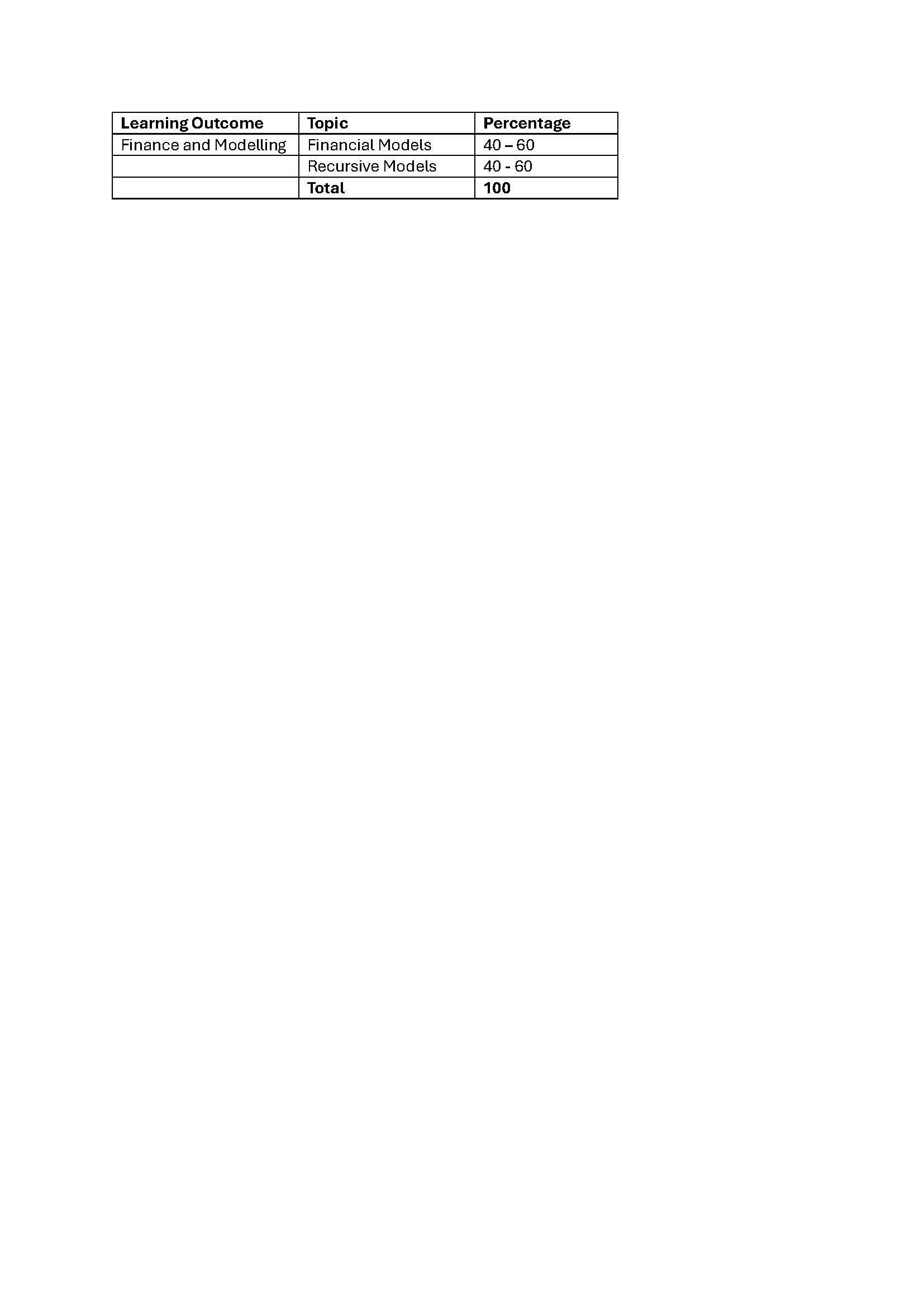




A.REQUIREMENTS
1.EXTERNAL ASSESSMENT (FINAL EXAMINATION)
Paper 1: (2 hours) (100 marks)
Section A: Reading for meaning. Unseen texts
This section will comprise two or three authentic texts, which can be in prose, visual and/or graphic form (60 marks)
Section B: Prescribed texts
Texts in this section will be based on the prescribed literature (short stories and poetry) (40 marks)
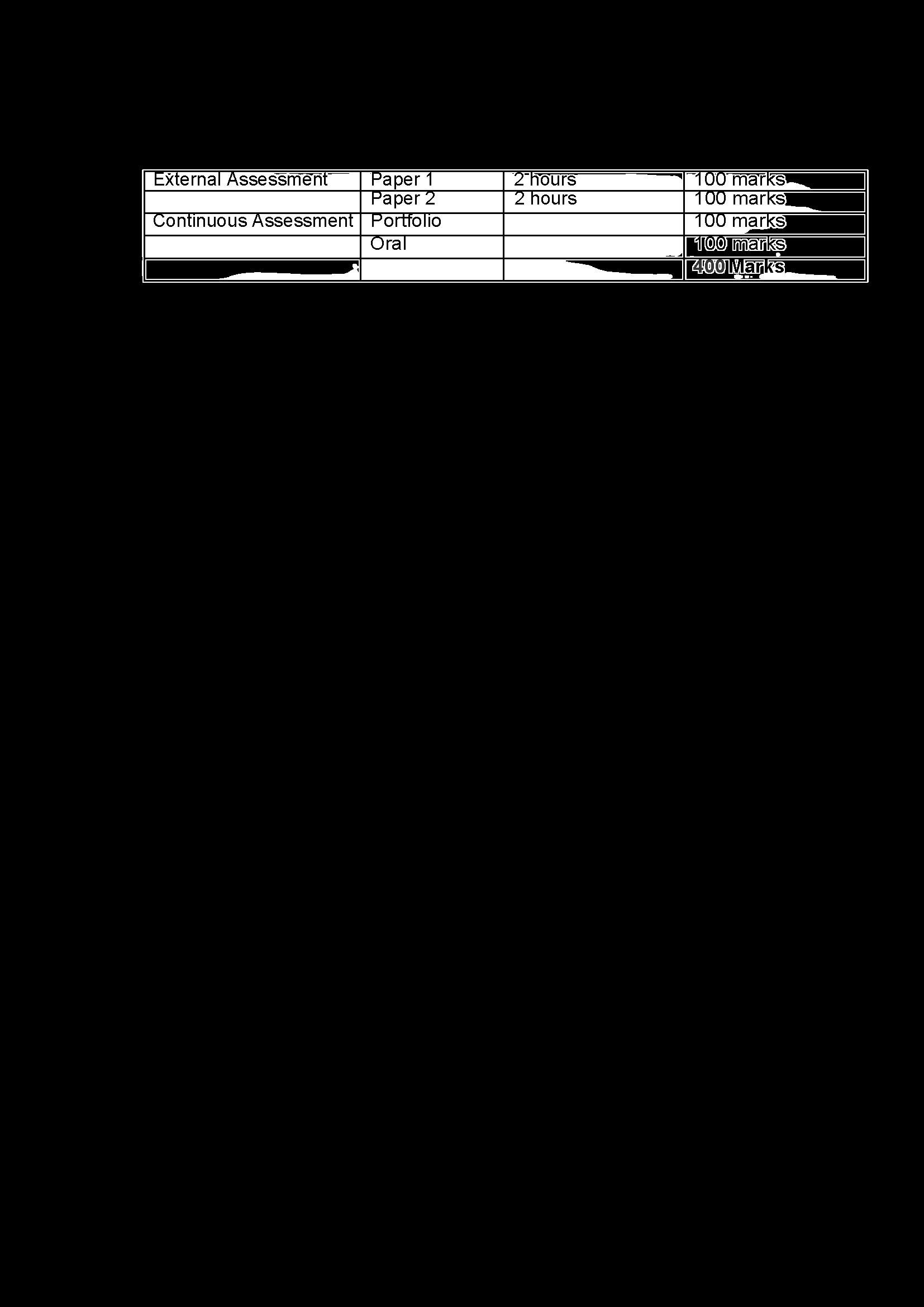
Paper 2: (2 hours) (100 marks)
Section A:
Writing a discursive text, expressing opinions Ideas and feelings (150 - 250 words) (30 marks)
Section B: 3 petits messages (50-70 words each) (30 marks)
Section C:
2 reformulations (100 - 150 words each) (40 marks)
2. SCHOOL-BASED ASSESSMENT (PORTFOLIO) (100 marks)
The portfolio consists of 8 representative pieces of work
Section A: Tasks (60 marks)
2 tasks written under controlled conditions (200 - 300 words) (30 marks)
2 tasks to be edited - one narrative and one discursive (300 -350 words each (30 marks)


Section B:Tests (20 marks)
A selection of 2 tests written throughout the year (20 marks)
Section C: Preliminary Examinations (20 marks)
Both paper 1 and paper 2 must be included (20 marks)
ORAL ASSESSMENT
The oral consists of the following 4 components: (100 marks)
1 Reading and discussion of previously prepared oral documents (20)
2 Role play situation (10)
3 Listening comprehension (30)
4 General conversation, potentially including poetry and literature (40)


A. MEANS OF ASSESSMENT
B. REQUIREMENTS
EXTERNAL ASSESSMENT (FINAL EXAMINATION) 1
PAPER I THEORY (3 hours) (200 Marks)
SECTION A - GEOGRAPHICAL ISSUES (100 MARKS)
This question is compulsory and covers all topics taught in Grade 12 in an integrated, thematic, issue-based manner
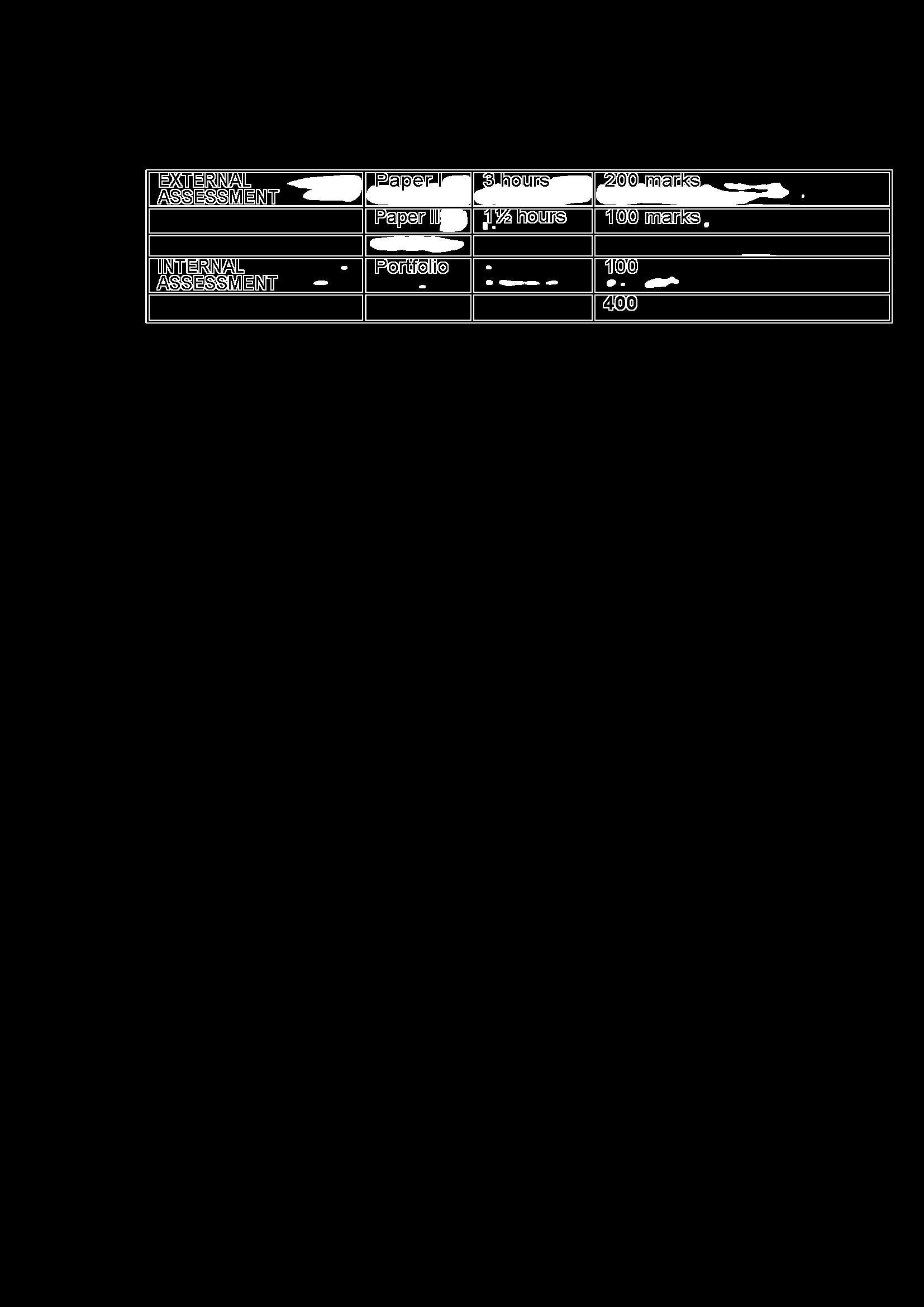
SECTION B - ATMOSPHERE AND GEMORPHOLOGY (50 MARKS)
This question is compulsory and examines topics covered within Atmosphere and Geomorphology.
SECTION C - SETTLEMENT AND ECONOMIC GEOGRAPHY (50 MARKS)
This question in compulsory and examines topics covered within Settlement and Economic Geography.
PAPER II MAPWORK (1½ hours) (100 MARKS)
GEOGRAPHICAL SKILLS, TECHNIQUES & INTERPRETATION
This paper is the practical paper and will assess students' knowledge, through interpretation, and their ability to apply geographical skills and techniques.
INTERNAL ASSESSMENT (PORTFOLIO) (100 MARKS)
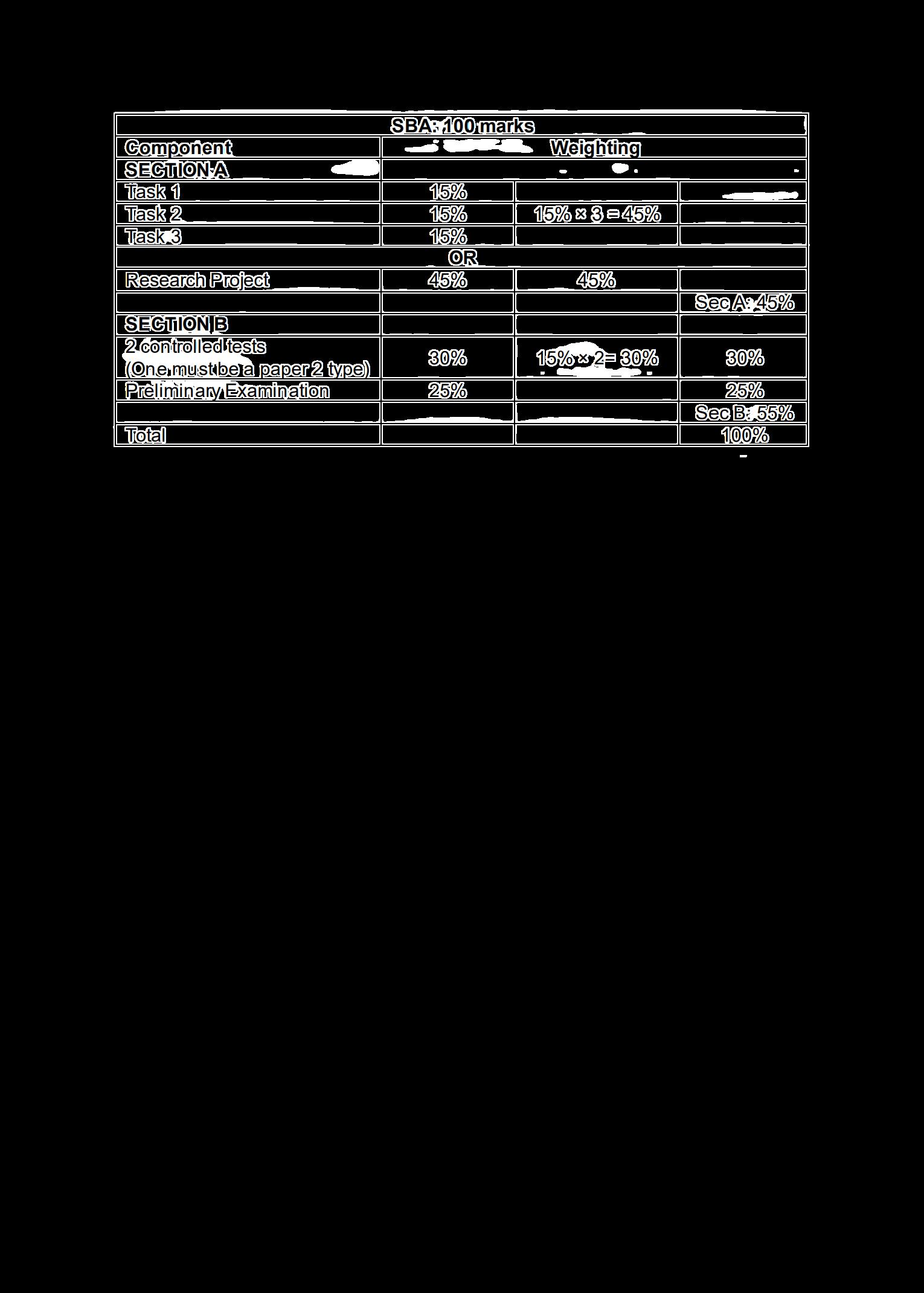


External Assesment Paper 1 2 hours
Internal Assessment Portfolio
B. REQUIREMENTS
1.
EXTERNAL ASSESSMENT (FINAL EXAMINATION)
marks
marks
PAPER I: Comprehension & Prescribed Texts (2 hours) (100 marks)
Section A: Two unseen comprehension texts (60 marks)
Section B: Prescribed Texts (40 marks)
Section A consists of 2 unseen articles based on themes which were taught in Grades 11 and 12
Section B consists of questions based on the prescribed texts Some questions are based on a short unseen text, which use the prescribed text as a point of departure Answers can be in an essay format or as a short paragraph
Paper 2: Creative Writing (2 hours) (100 marks)
Section A: Discursive/Narrative Essay, expressing opinions, ideas and feelings (30 marks) The essay, of about 1 ½ page, is based on a given short paragraph, connected to the topic, to which the students have to refer in their essays
Section B: Formulation of Information (30 marks) This consists of activities such as short messages, Letter, Email, Dialogue, Advert, Journal, Picture etc
Section C: Reformulation of Information & Synthesis (40 marks) Students have to reformulate one genre of writing to another (e.g. from letter to dialogue). In the synthesis section, they get details in point form and have to create a paragraph.


2. INTERNAL ASSESSMENT (PORTFOLIO) (100 marks)
Tests and Exams - Class work The tests based on learnt texts (80 marks)
The Preliminary Examination (20 marks)
3. INTERNAL ASSESSMENT (ORAL) (100 marks)
The oral assessment consists of the following components:
• Reading and Discussion of a previously prepared specific articles. (20)
• Conversation on the prescribed texts (literature) (20)
• General conversation (20)
• Role Play /Situation (dialogue) (20)
• Listening to unseen text (Comprehension) (20)
There will be Internal and External moderation.


A MEANS OF ASSESSMENT
Assessment
B. REQUIREMENTS
- School-based Assessment
1.EXTERNAL ASSESSMENT (FINAL EXAMINATION)
PAPER 1: EXTENDED WRITING PAPER (2 hours) (100 marks)
THREE themes will be prescribed for this paper. As with Paper 2, the prescribed themes will rotate.
The Themes for 2024 are:
Topic 1 The Cold War, Case Study: Vietnam
Topic 3 Civil Society Protects (1950s to 1970s)
Topic 4 Civil Resistance in South Africa (1970s and 1980s)
Section A: Discursive Essay (70 marks)
THREE questions will be set, one on each of the THREE prescribed themes. Candidates will be required to answer ONE question. The Discursive Essay should be approximately 800 - 900 words in length.
Section B: Extended Writing (30 marks)
THREE questions will be set, one on each of the THREE prescribed themes Candidates will be required to answer ONE question The Extended Writing should be approximately 350 - 400 words in length
A source will be given as a stimulus to direct the learner’s response, but it will not require analysis The task will be sub-divided to provide further clarity to guide the learner’s response


PAPER 2: SOURCE-BASED PAPER (3 hours)
(200 marks)
THREE themes will be prescribed from the Grade 12 Content section of the Curriculum and Assessment Policy Statement (CAPS) The themes prescribed will be rotated All questions are compulsory
The Themes for 2023 are:
Topic 2 Independent Africa (1950s to 1970s)
Topic 5 Coming of Democracy: Coming to Terms with SA's Past
Topic 6 End of the Cold War and a New World Order: 1989 to present
Section A: Single-Source Analysis (3 x 20 marks) (60 marks)
Three questions will be set across at least two of the set themes. Each question will focus on an analysis of a single source.
The format of these questions will take the following form:
One will require a textual analysis
One will be a visual analysis
One will link a theme to a current issue in the media. This will require the candidates to make links between events and issues from the past with the present.
Questions will require broad historical understanding, but will also focus on specific historical skills, such as analysis, evaluation of written and visual sources, as well as engaging with issues of reliability and usefulness.
Candidates will be required to do all three questions.
Section B: Source Based Questions (90 marks)
There will be one set of questions based on a range of different sources from one or more of the three prescribed key questions/themes.
Section C: Source Based Essay (50 marks)
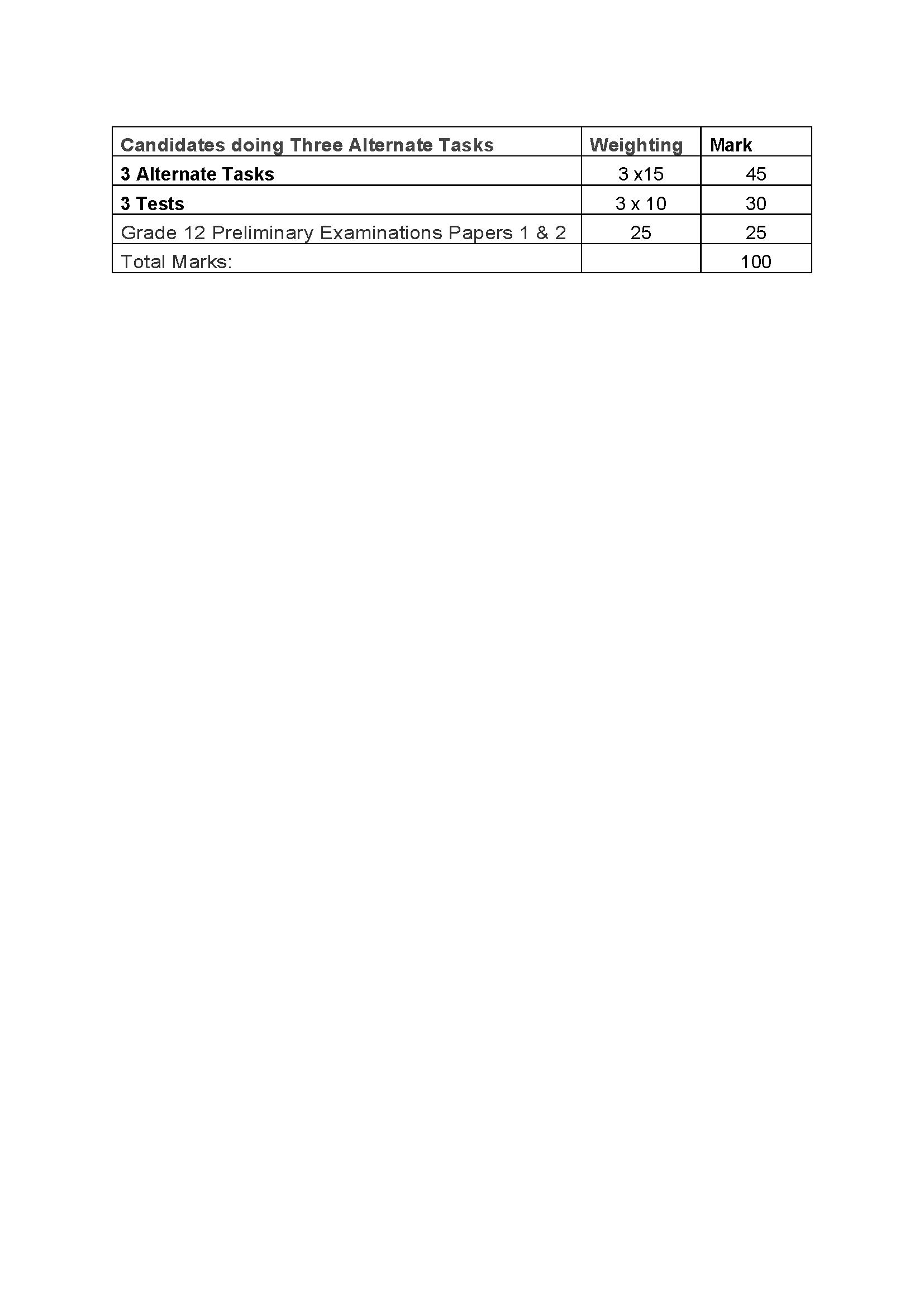


Assesment
1. EXTERNAL ASSESSMENT (FINAL EXAMINATIONS)
Paper 1: PRACTICAL (3 hours) (150 reduced to 100 marks)
DETAILS OF PAPER I: PRACTICAL EXAMINATION
In the three hours of the examination, candidates will be required to develop. Solutions for one or more unrelated problems, each of which may have more than one section. The practical exam will only examine Databases (accessed via SQL statements from a SQL browser) 50 marks and object-oriented programming +- 100 marks.
DETAILS OF PAPER 2: THEORY EXAMINATION

Paper 2: THEORY (3 hours) (150 reduced to 100 marks)
2. PERFORMANCE ASSESSMENT TASK (PAT) (100 marks)
The programming project represents the development cycle of a product The purpose is to give the learner a meaningful experience of a larger project and development cycle than is usually possible in a classroom situation
To be fair to the learner and to ensure a good product at the conclusion of the project it should be completed (and assessed) in 5 phases


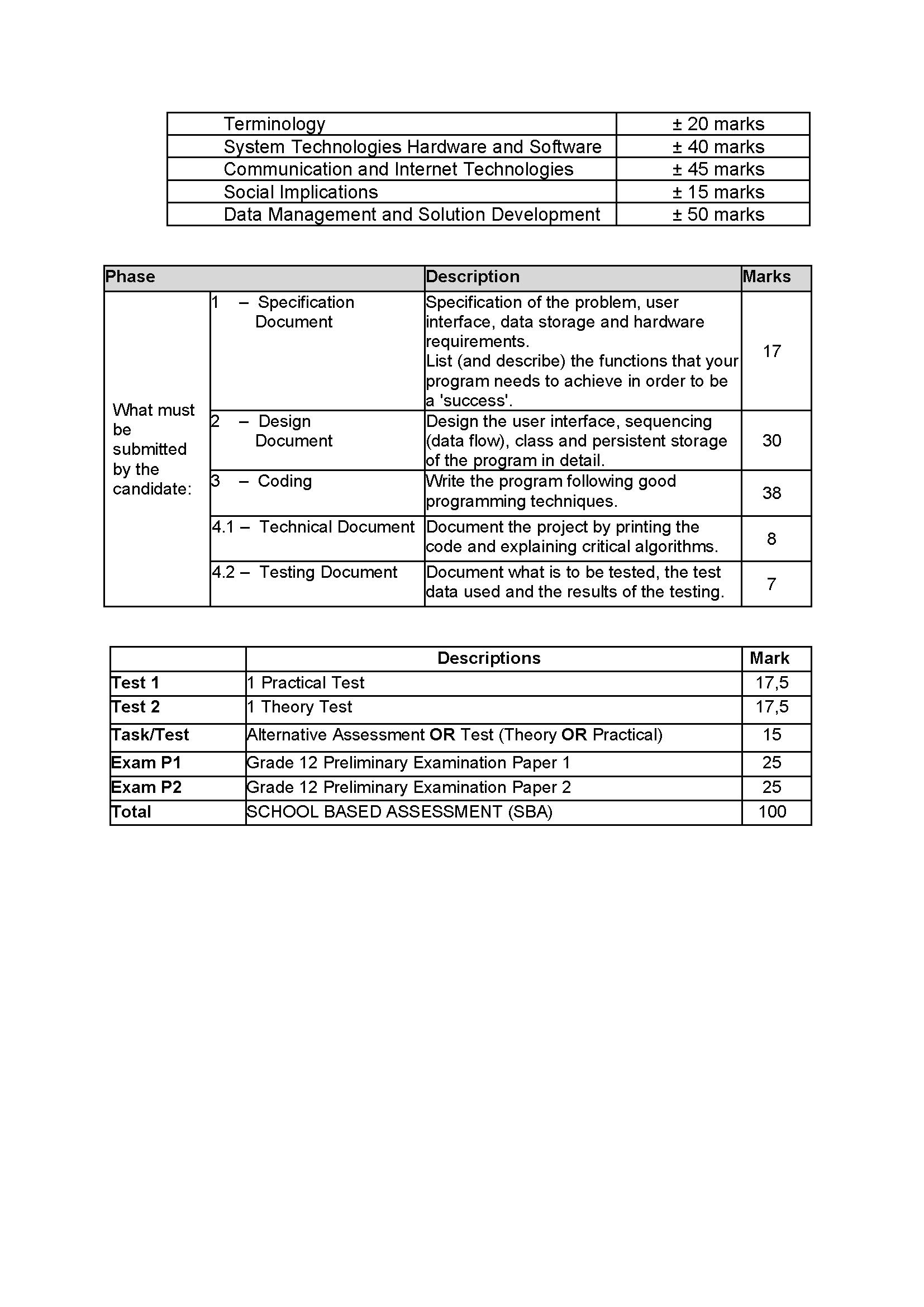

3. INTERNAL ASSESSMENT (SBA)
Table 1: Requirements for School Based Assessment (SBA)


B. REQUIREMENTS



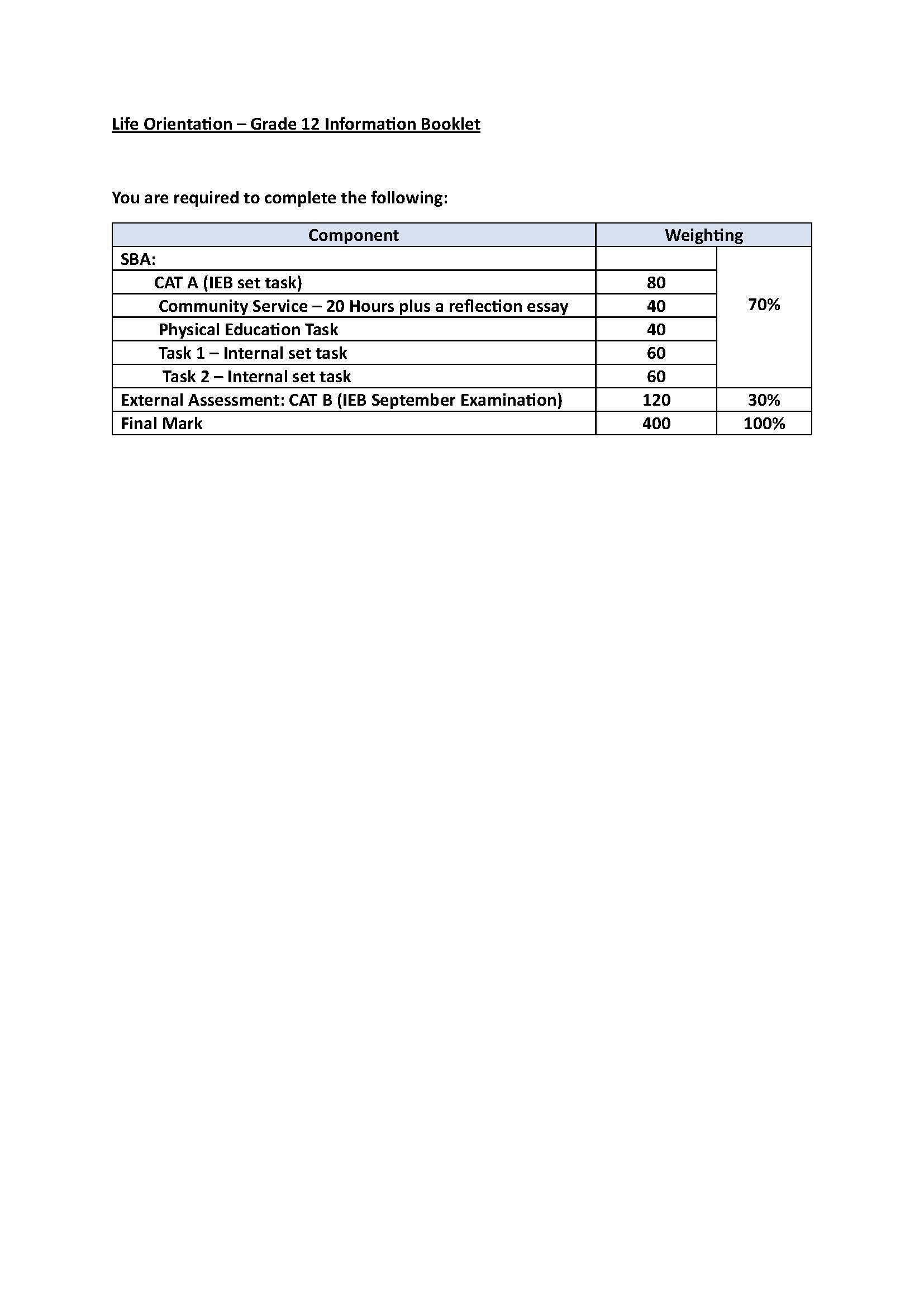


External Assesment
Internal Assessment Portfolio
B. REQUIREMENTS
1. EXTERNAL ASSESSMENT (FINAL EXAMINATION)
Paper 1: (3 hours)
Assesses AIMS 1, 2 and 3 of the following THREE Strands
Life at molecular, cellular and tissure level
Environmental studies Diversity, change and continuity of life
Paper 2: (2 hours)
Assesses AIMS 1, 2 and 3 of the following strand
Life processes in plants and animals
marks
350 marks converted to 300
marks 400 marks
(200 marks)
(100 marks)
Paper 3: (1½ hours) (50 marks)
Practical examination
This has two parts. Candidates must demonstrate both their ability to design an experiment and evaluate an existing experiment (given to them) as well as perform a simple Experiment Procedure in order to collect, graph, analyse and interpret data.
2. INTERNAL ASSESSMENT (PORTFOLIO)
Number of pieces: 5
100 marks
Preliminary Examination/Trial paper (25 marks)
Standardised Test 1 (15 marks)
Standardised Test 2 (15 marks)
Compulsory Summative Practical
2 Tasks taken from Research project / Case Study / Controlled writing/Summative Practical (30 marks)


External Assesment
B.REQUIREMENTS
Included with the papers is a formula sheet.
1.EXTERNAL ASSESSMENT (FINAL EXAMINATION)
Paper1: Description
Algebra and Equations (and inequalities)
± 3 Patterns and Sequences
± 3 Finance, growth and decay
± 3 Functions and Graphs
± 3 Differential Calculus
TOTAL (150)
Paper 2: Description
Geometry and Measurement Trigonometry
Trigonometric graphs will only be examined in Paper 2
2. INTERNAL ASSESSMENT (PORTFOLIO)
Section A: Tests and Examinations
3 tests from a variety of topics (30)
Preliminary Examination Paper 1 (20)
Preliminary Examination Paper 2 (20)
Section B: Alternate forms of Assessment
Long Item (30) Total (100)
3


A. MEANS OF ASSESSMENTS
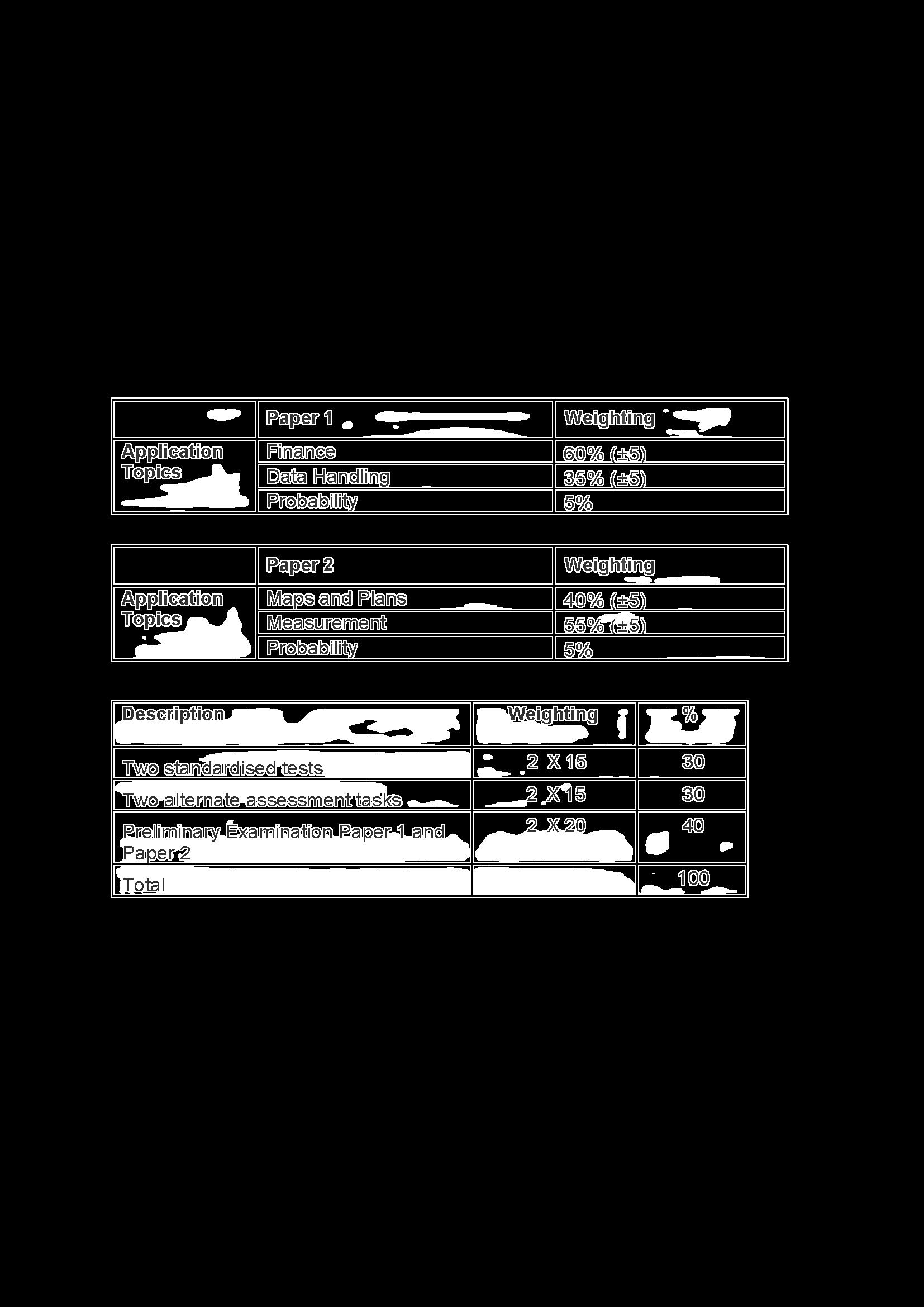

B. REQUIREMENTS
Included with the papers is a formula sheet.
EXTERNAL ASSESSMENT (FINAL EXAMINATION PAPER 1 and PAPER 2) 1.
2. INTERNAL ASSESSMENT (PORTFOLIO) (100marks)


B. REQUIREMENTS
Both papers are written on the same day and the whole syllabus – ‘Music Knowledge and Analysis’ and ‘Music Literacy’ - is examined over both papers.
1. EXTERNAL ASSESSMENT
PAPER I (100 Marks)
An MP3 player is provided for all candidates with approximately 20 pre-recorded tracks Paper I contains an essay Critically evaluate representative examples of music and compare different styles of music
2. EXTERNAL ASSESSMENT
PAPER 2 (50 Marks)
Candidates will be required to analyse notated music
3. EXTERNAL ASSESSMENT
PRACTICAL EXAM (100 Marks)
Demonstrate sight reading skills (10)
Demonstrate aural skills (10)
Demonstrate technical control over chosen instrument – scales and technical exercises (10)
Perform a variety of solo pieces (70)
4.EXTERNAL ASSESSMENT
PRACTICAL SBA (50 Marks)
Improvise stylistically using traditional, indigenous or contemporary scales and modes and/or rhythmic styles (15)
Perform a variety of solo pieces (20)
Perform a variety of pieces in group context (15)


1. PORTFOLIO
TASKS:
(A Total of 150 Marks Converted to 100 Marks)
Task 1: Programme Notes (10)
Write programme notes for examination pieces
Task 2: Composition and arrangement (30) Composition and arrangement: use available technology to compose, arrange and present a musical work
Task 3: Harmony and Composition (20)
Apply knowledge of music literacy and harmony to complete a four-part harmony under controlled classroom conditions
Task 4: Melody Writing (10)
Using notational software, write melodies of up to 16 bars in all studied scales OR Write 12-bar melodies with words. This task is completed under controlled classroom conditions.
Task 5: Critically evaluate representative examples of music (30) Compare different styles of notated, recorded and performed music within varied historical contexts.
School-based Assessments (50)
Two summative tests (2 × 10 marks)
Preliminary theory examination (30 marks)


A. MEANS OF ASSESSMENTS
External Assesment
Internal Assessment (SBA) Porfolio (Cass)
B. REQUIREMENTS
A REQUIREMENTS
1. EXTERNAL ASSESSMENT (FINAL EXAMINATION)
200 marks (scaled to 150 marks)
200 marks (scaled to 150 marks)
100 marks
A variety of questioning styles will be employed in the final examination with a maximum of 10% of the marks being in the multiple-choice format.
Table 1 Physical Sciences Paper 1 (Physics)
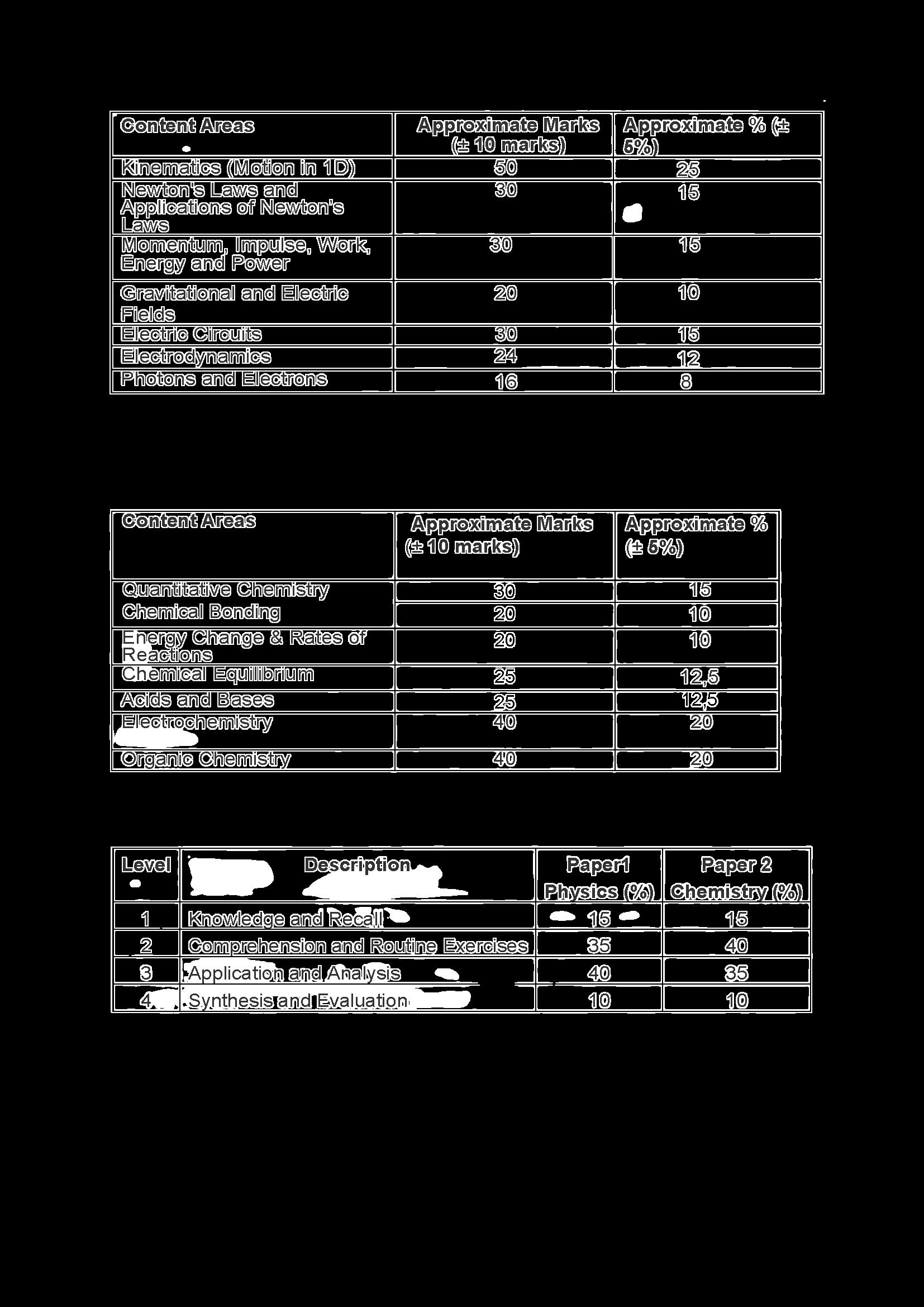

Table 2 Physical Sciences Paper 2 (Chemistry)
TABLE 3 WEIGHTING OF EXAMINATION ACCORDING TO TAXONOMY OF COGNITIVE LEVELS
1.2 INTERNAL ASSESSMENT (PORTFOLIO)
AMENDED IEB SBA REQUIREMENTS FOR 2024
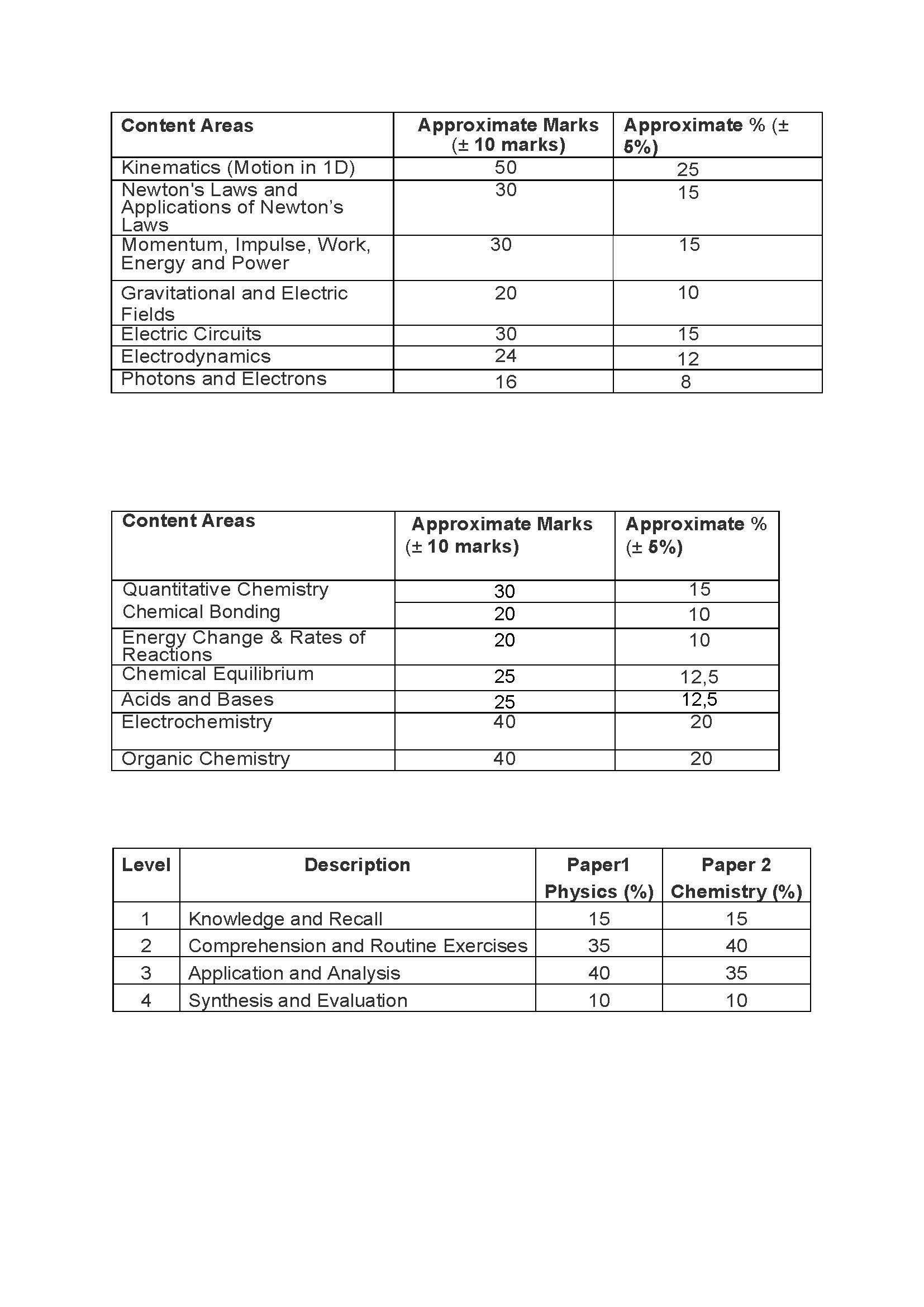
*2 g (1 Physics focus; 1 Chemistry focus)

Controlled Test (Physics focus)
Controlled Test (Chemistry focus)
NB: midyear examinations may be used
NB: Alternative Assessment may be used in place of one test
NB: There must be 1 Physics focus and 1 Chemistry focus assessment
Preliminary examinations
Total marks


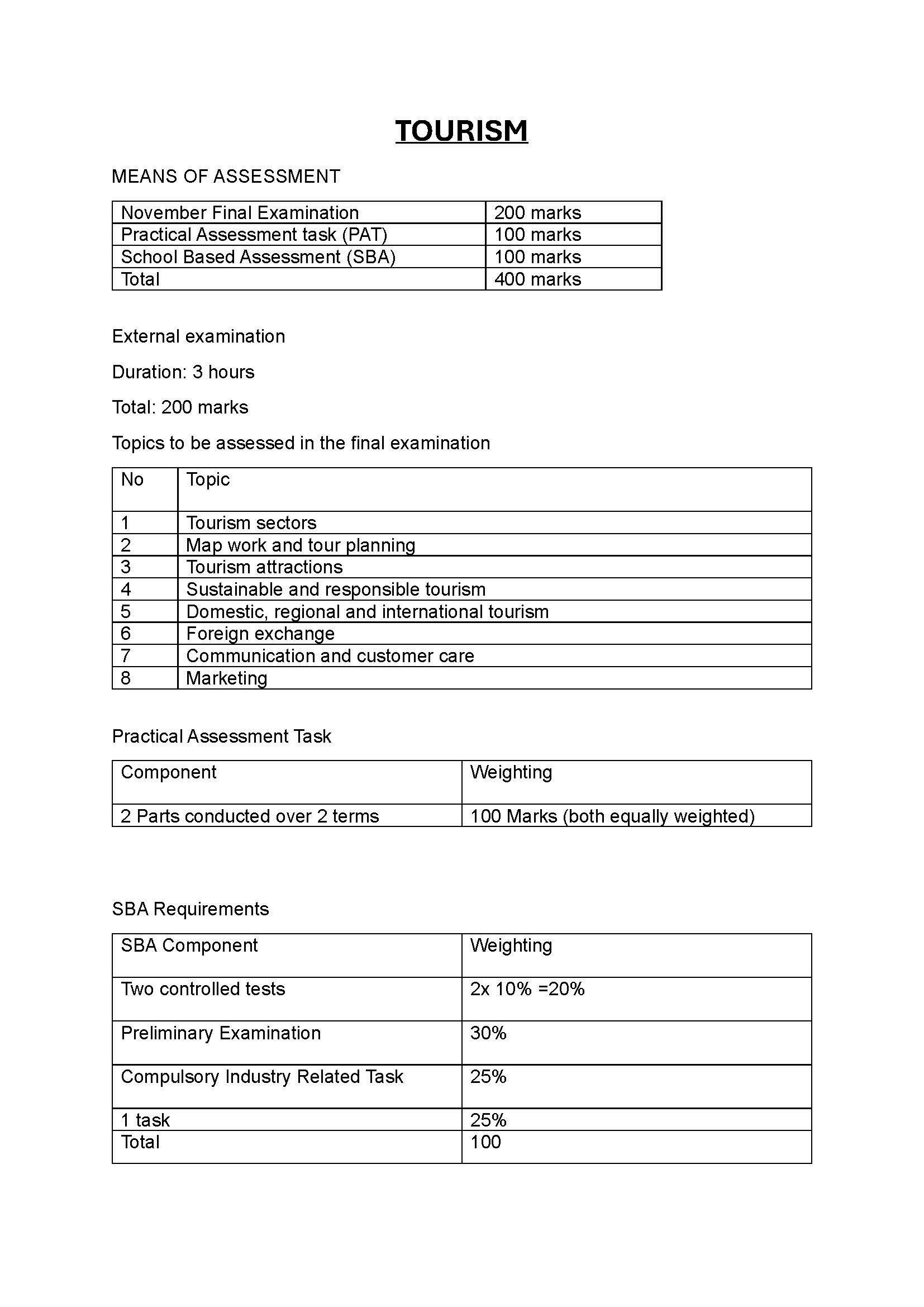


External Assessment Paper 1 (Theory) 3 hours
100 marks Paper 2 (Practical February to September 100 marks
Internal Assessment Portfolio Tasks
Research Essay
SBA Artwork
SBA Drawing
SBA Visual Diary
SBA Theory Tests
Prelim Examination
200 marks
Total marks
B. PRACTICAL
400 marks
Assessment in Visual Arts in Grade 12 takes the form of ELEVEN School Based Assessments and TWO Examinations
ASSESSMENT TASKS FOR THE SBA PRACTICAL PORTFOLIO
PAT : Creative Process (20 marks)
PAT: Contextual Research (10 marks)
PAT:
Drawing/s (35 marks)
PAT : Artwork (35 marks)
EXAMINATION PAPER 2 – PRACTICAL
Requirements for the practical examination are as for the SBA tasks above.


C: THEORY
SBA TASKS FOR VISUAL CULTURE STUDIES
SBA Task 4: Conclusive Research Essay (30 marks)
SBA Task 5: Visual Literacy Test (15 marks)
SBA Task 6:
Shorter paragraph questions on Dada, Surrealism, etc. (15 marks)
SBA Task 7:
Shorter paragraph questions on International Current and Conceptual Art. (20 marks)
SBA Task 8:
Shorter paragraph questions on South African Resistance Art including the Polly Street School and Rorke’s Drift. (20 marks)
SBA Task 9:
Long essay question on South African Contemporary Art. (30 marks) (Note – Tasks 5 to 9 - done as mini prelim.
SBA Task 10:
Preliminary Examination (Mirrors content of Paper 1) (100 marks) (Note - this mark converted to be out of 30)
EXAMINATION PAPER 1 – VISUAL CULTURE STUDIES
(100 MARKS)
Q1 Visual Literacy (15 marks)
Q2 Dada, Surrealism, etc (15 marks)
Q3 International Art (20 marks)
Q4 South African Resistance Art (20 marks)
Q5 South African Essay (30 marks)
TOTAL: 400 MARKS


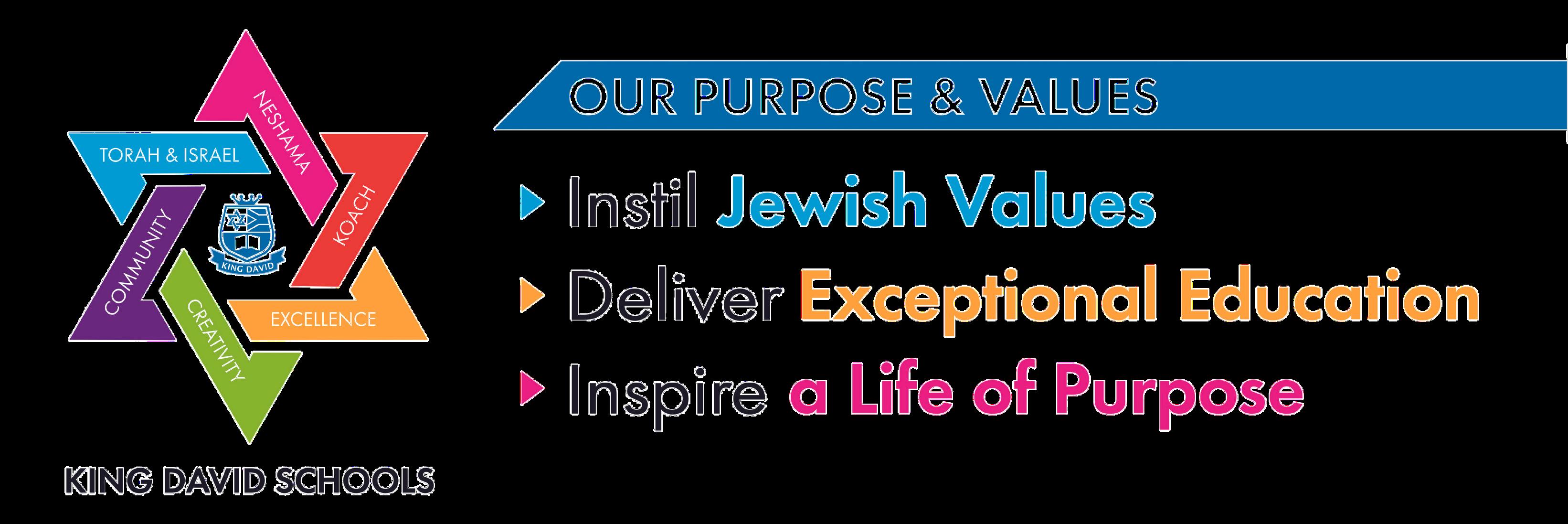
Torah & Israel
Pride in our Jewish identity and values. Knowledge of Jewish heritage and tradition. Gratitude and love for our Jewish State and all it has achieved.
Community
Proudly South African with a deep connection to our Jewish community, our fellow South Africans and commitment to making the world a better place.
Koach
Energy & passion to achieve the extraordinary while remaining humble. The will to face setbacks with faith, resilience and strength.
Neshama
Care & respect for each individual. Striving to always be a mensch and live a life of kindness and empathy.
Creativity
A focus on problem solving, innovation and collaboration, incorporating cutting edge technology and creative arts.
Excellence
Being the best version of oneself. Working with integrity and professionalism.